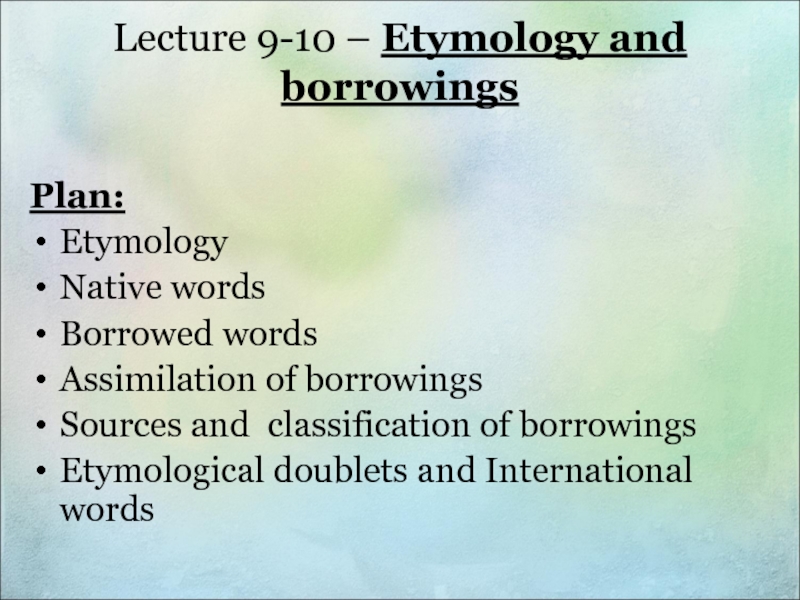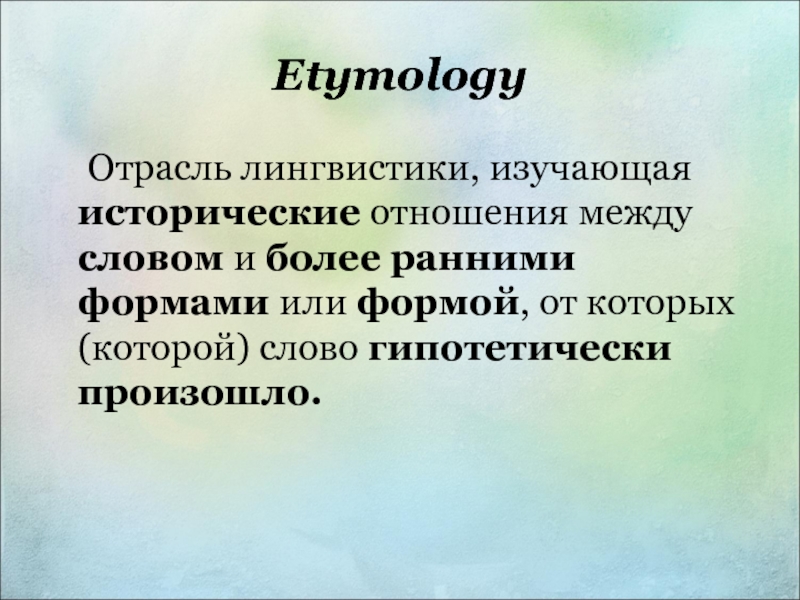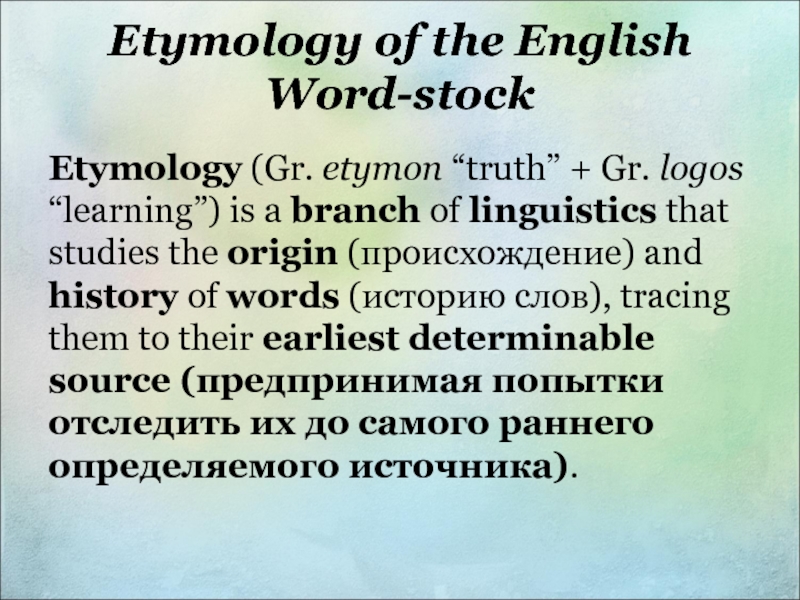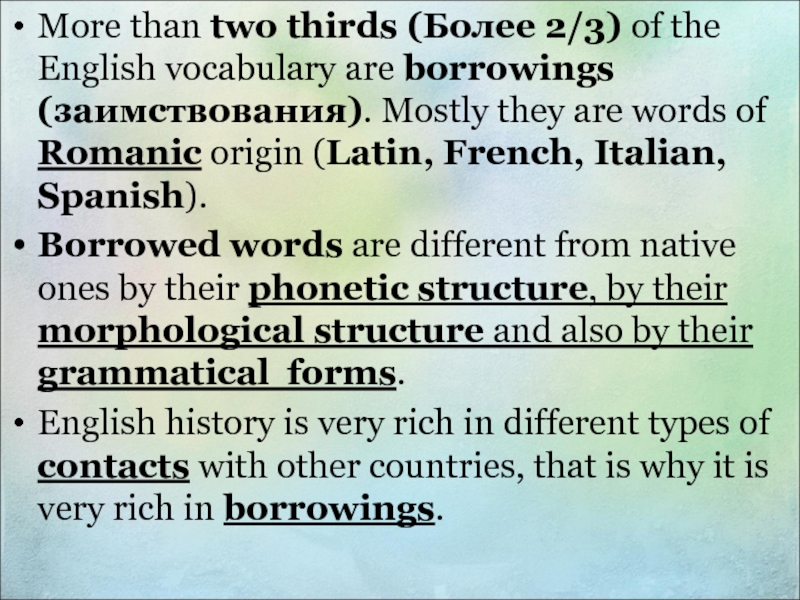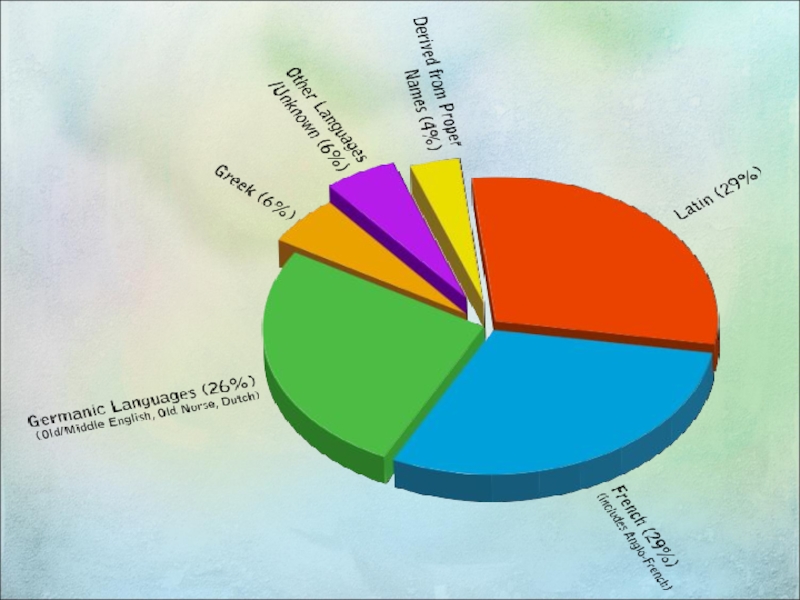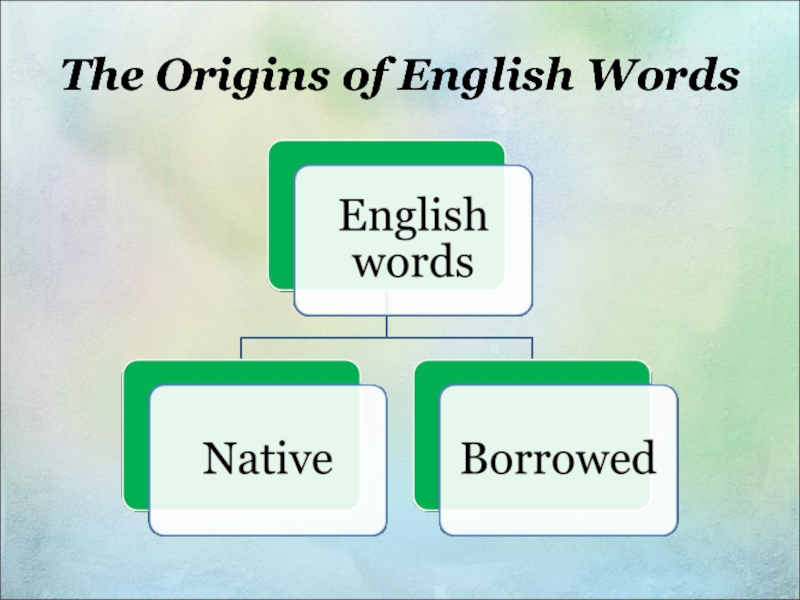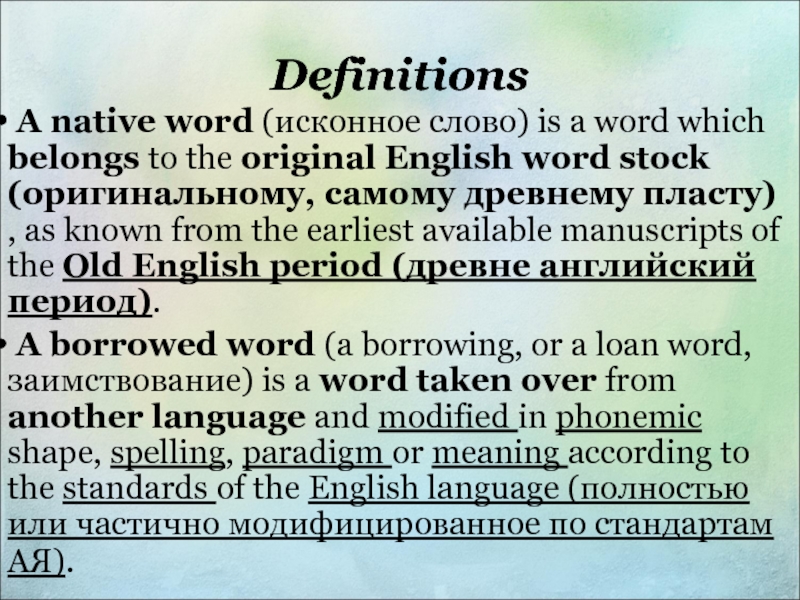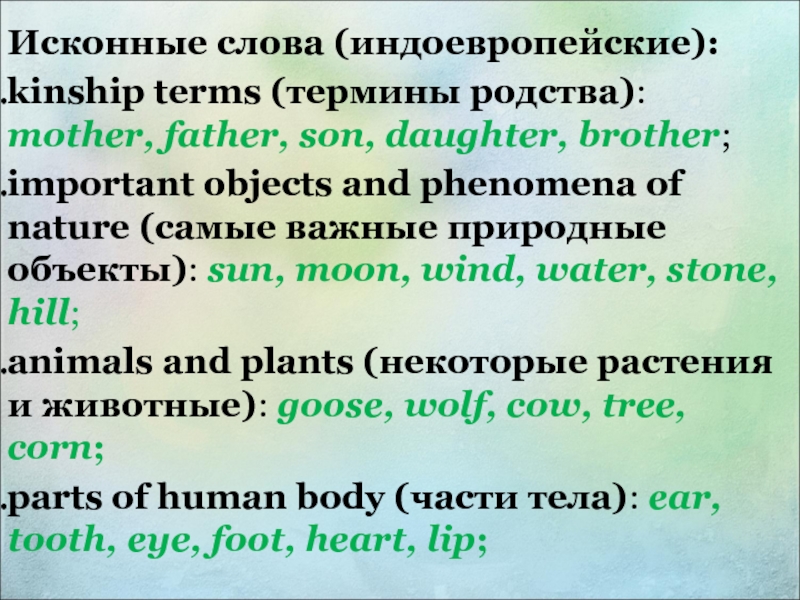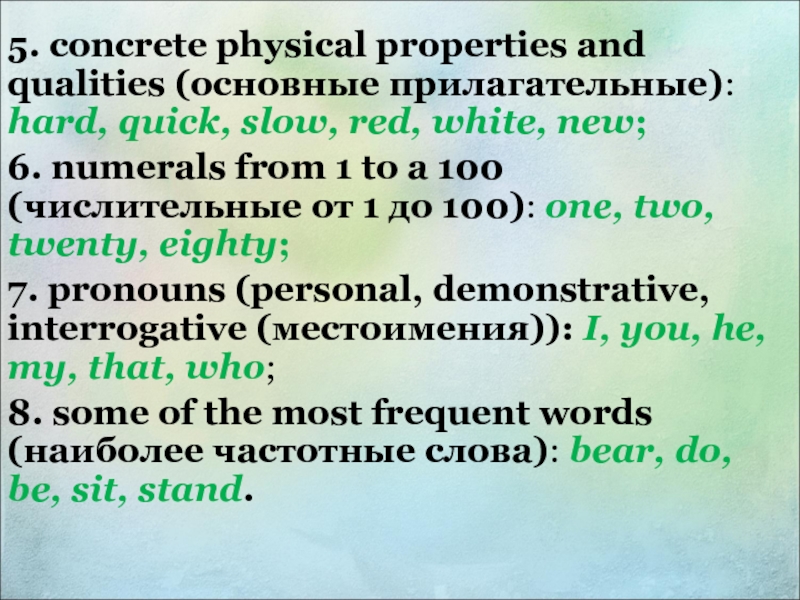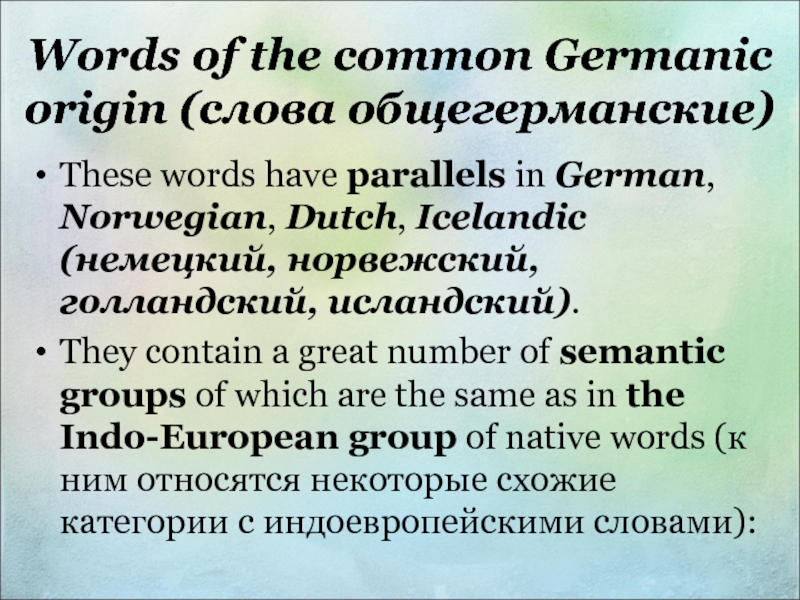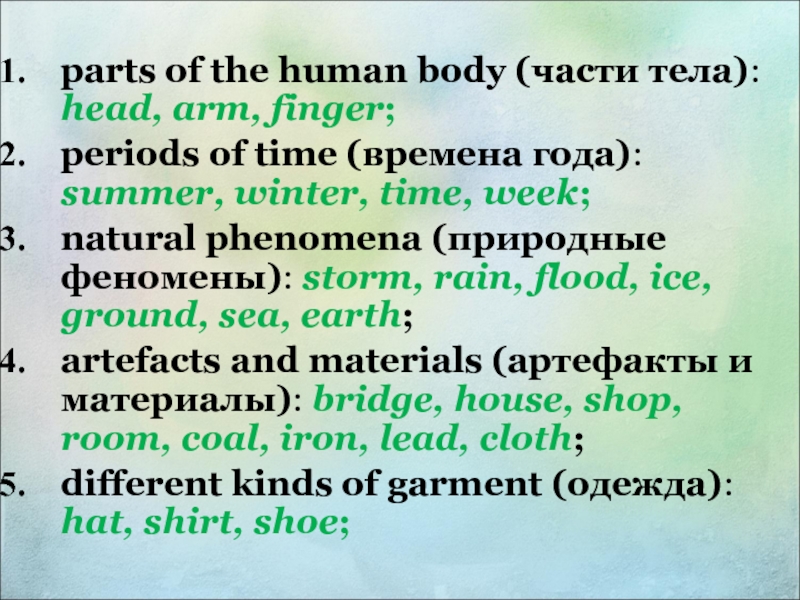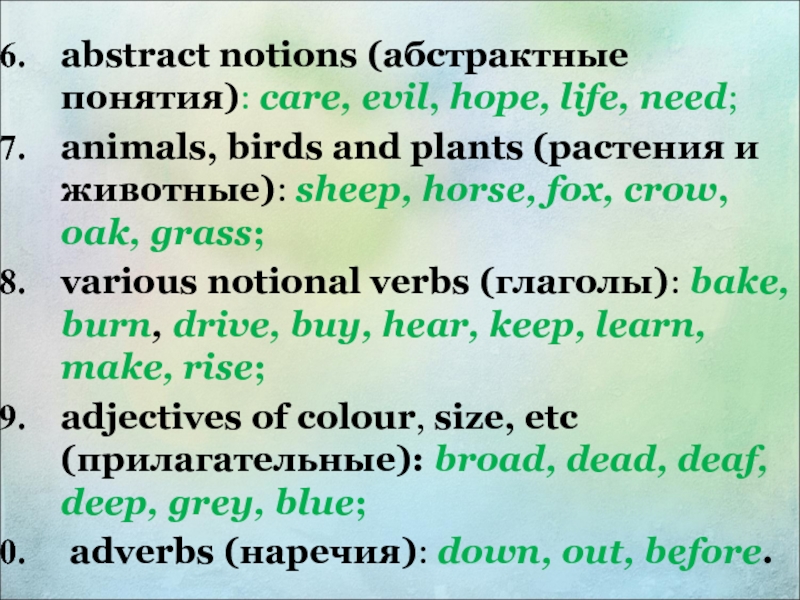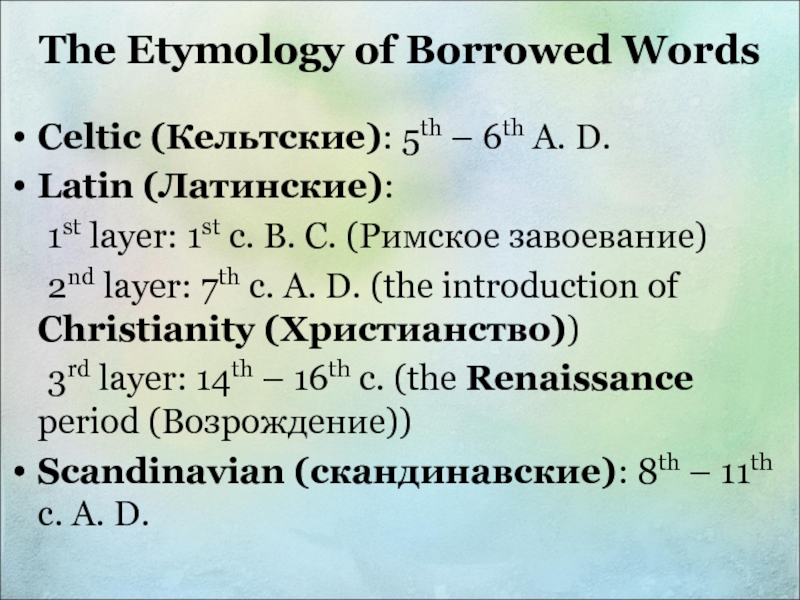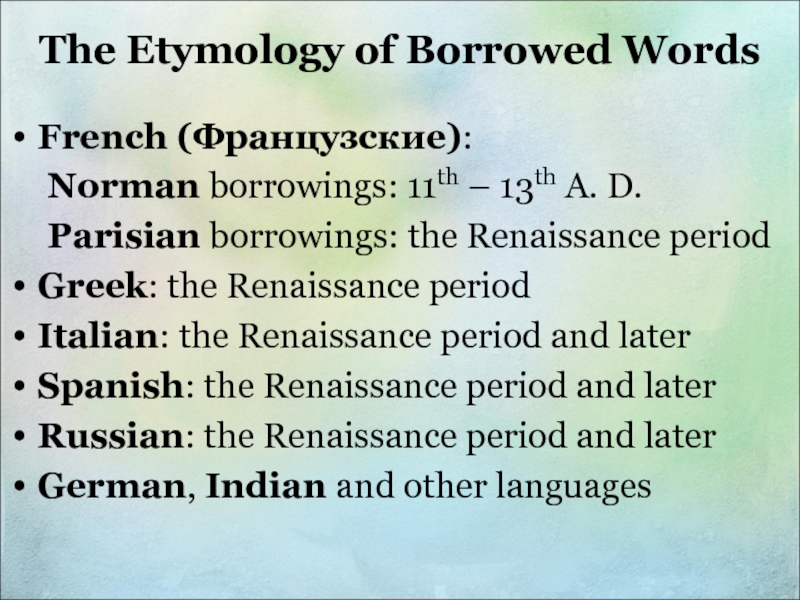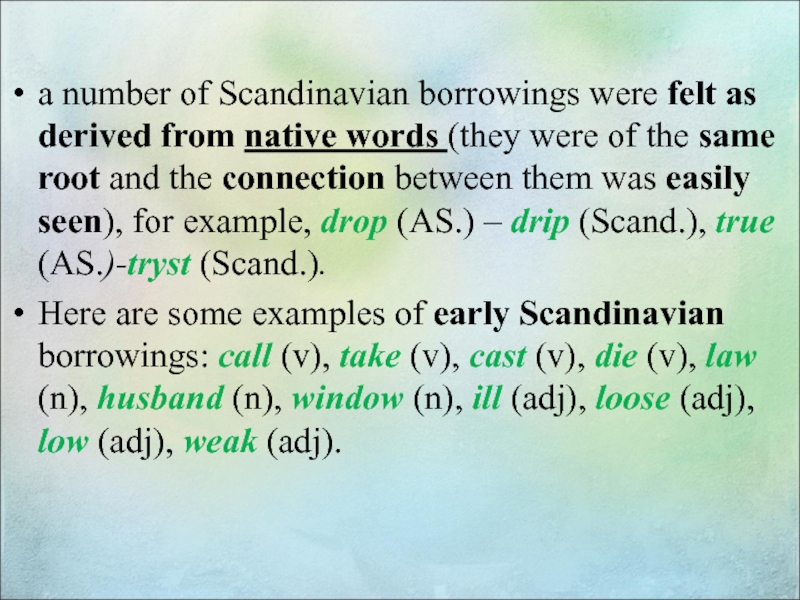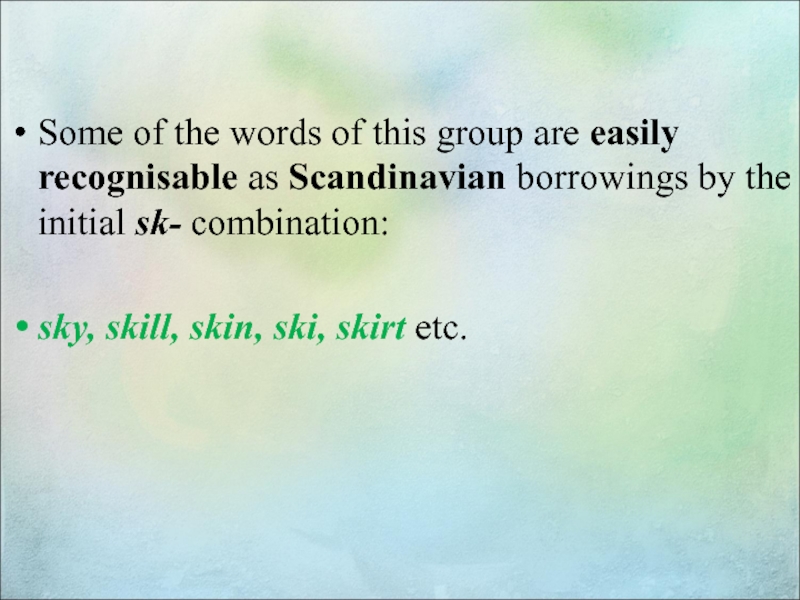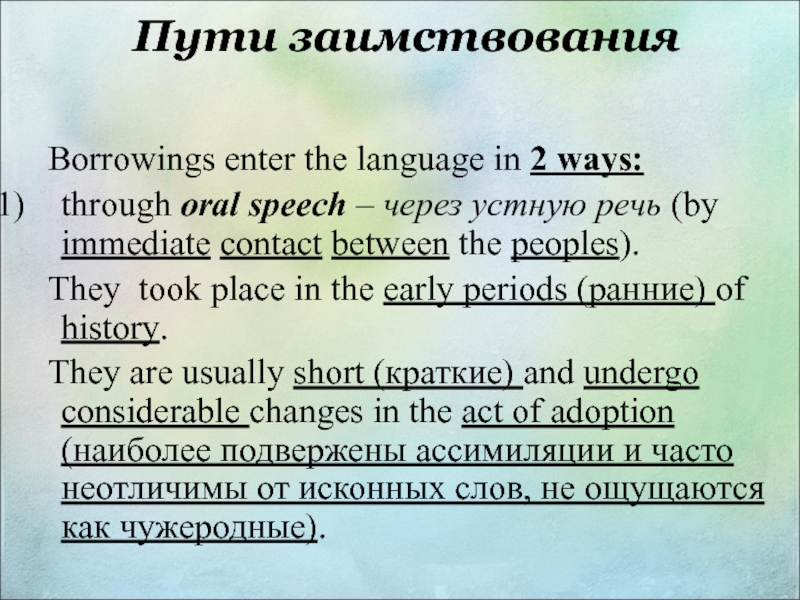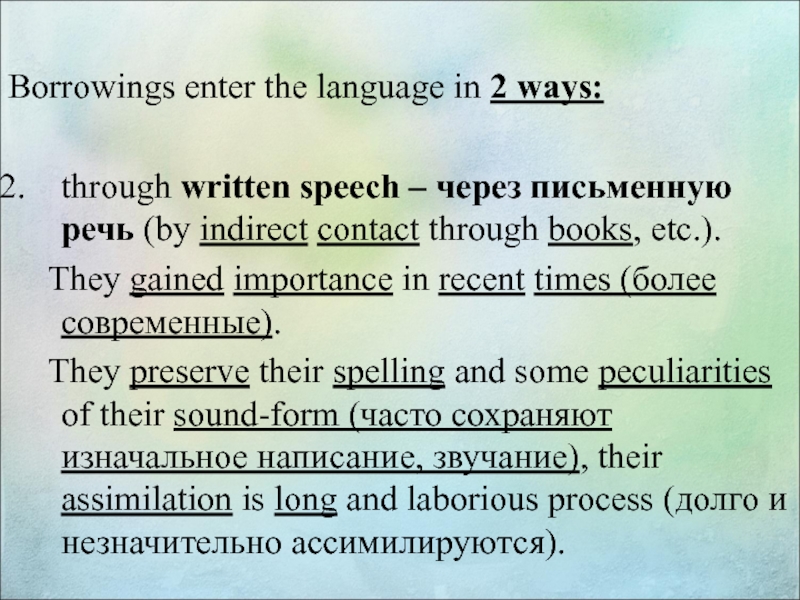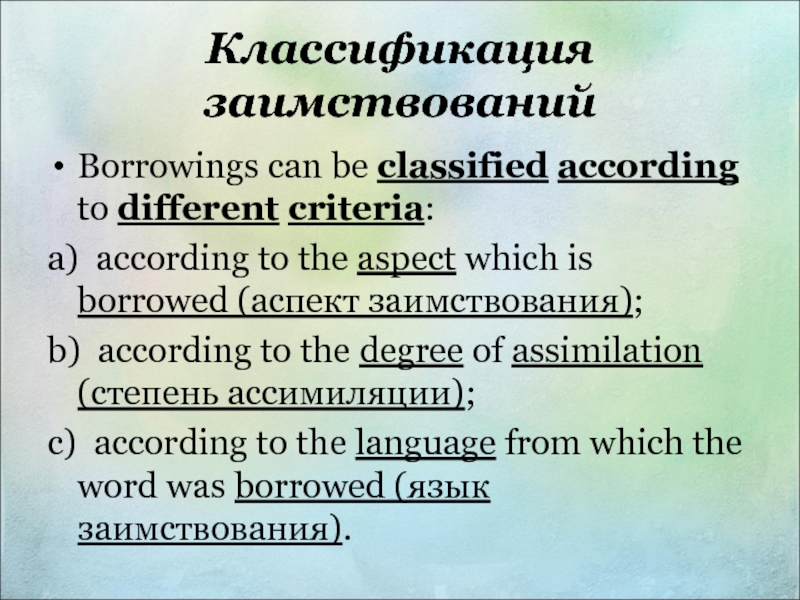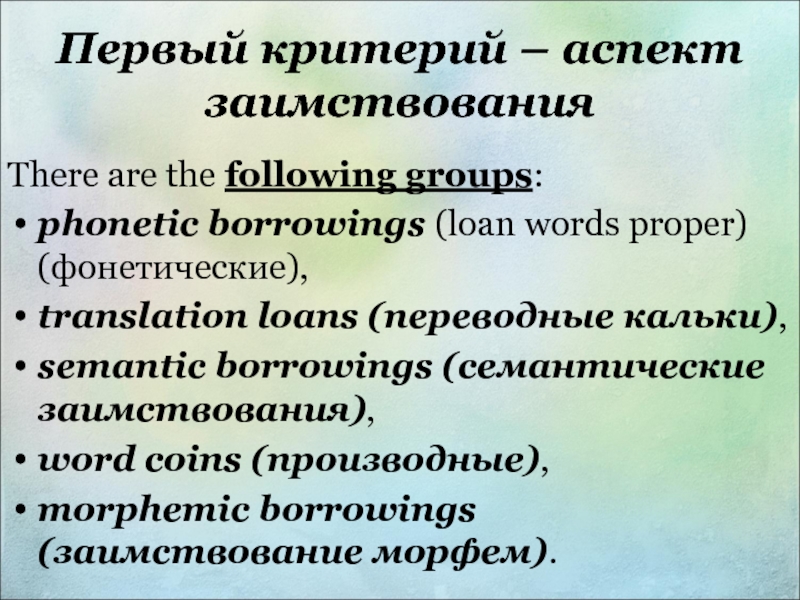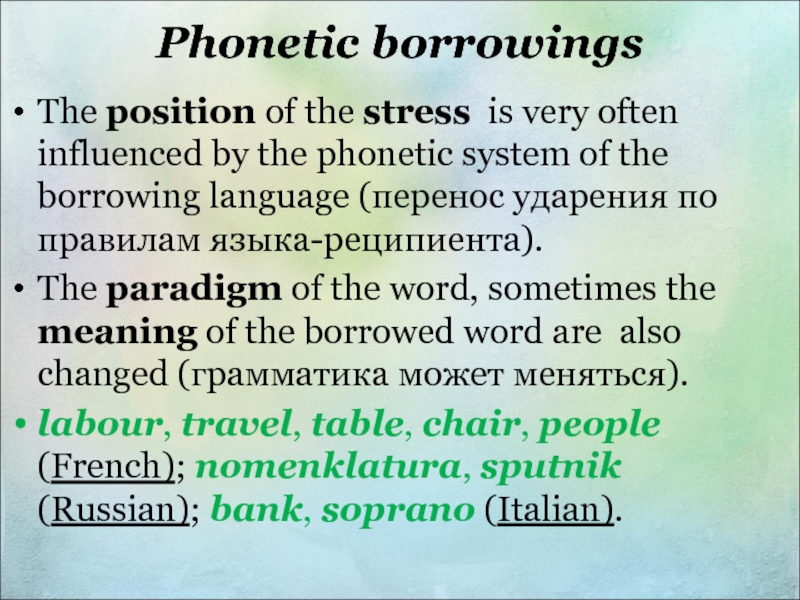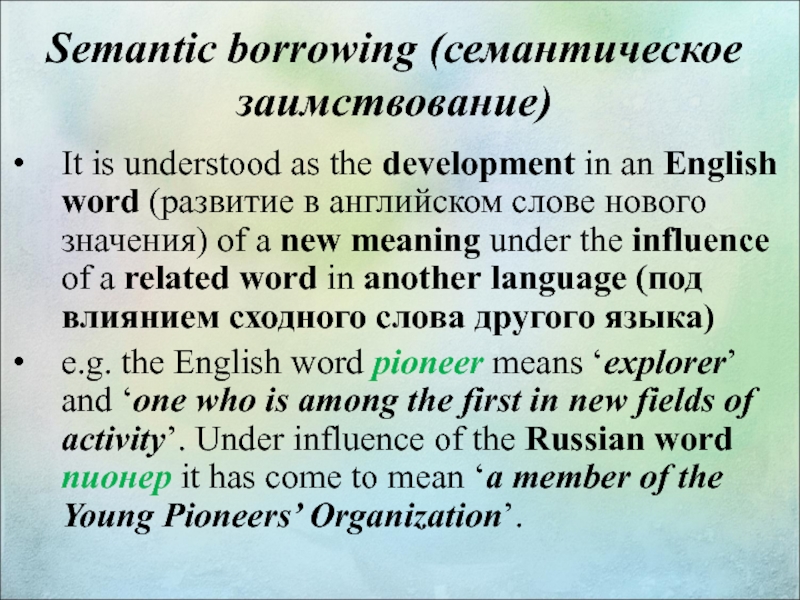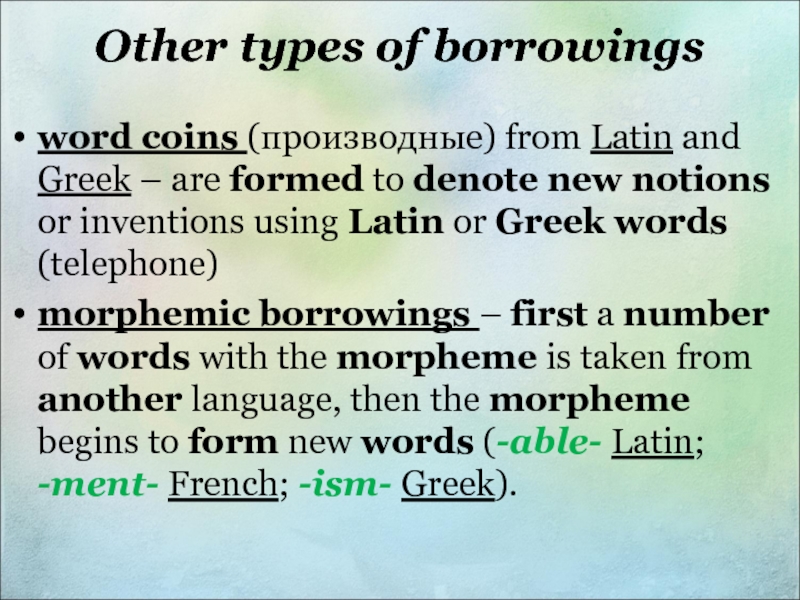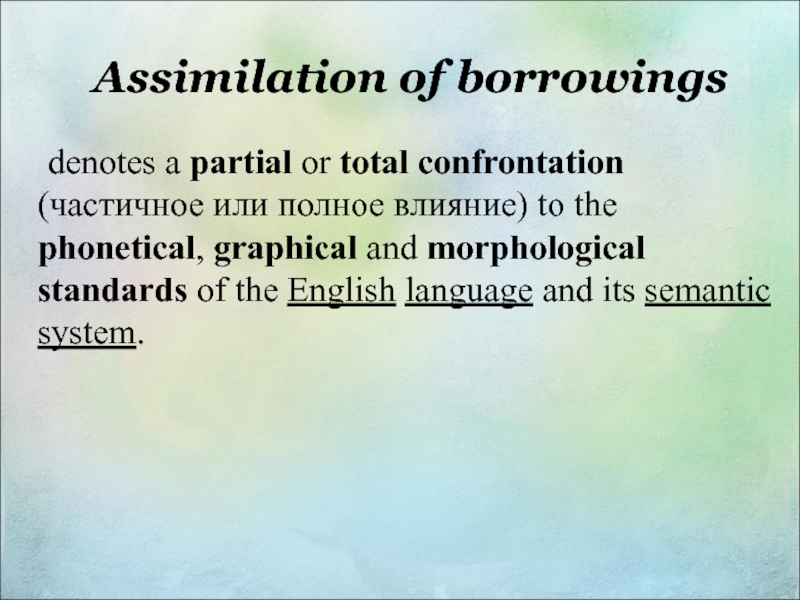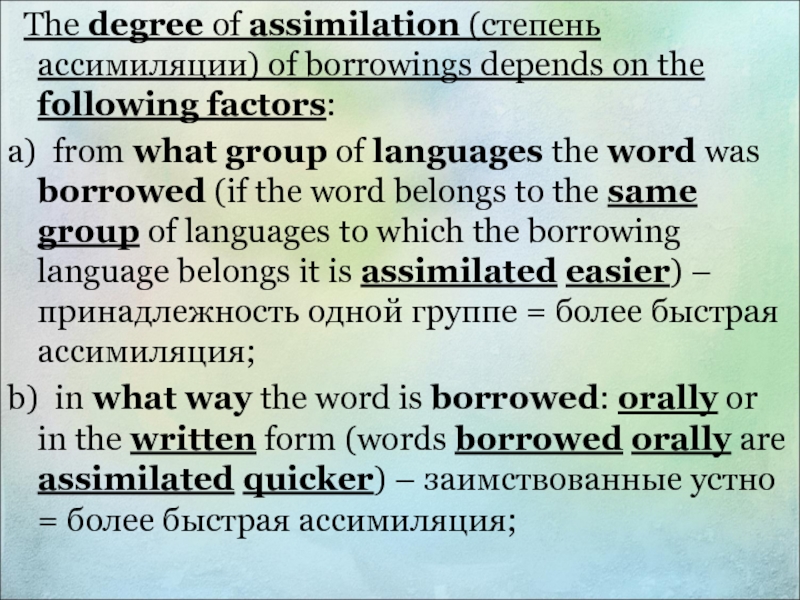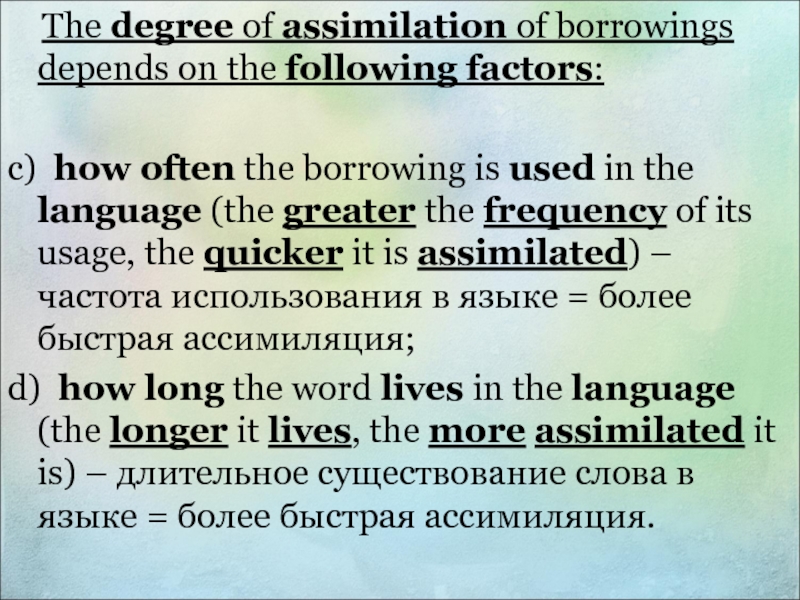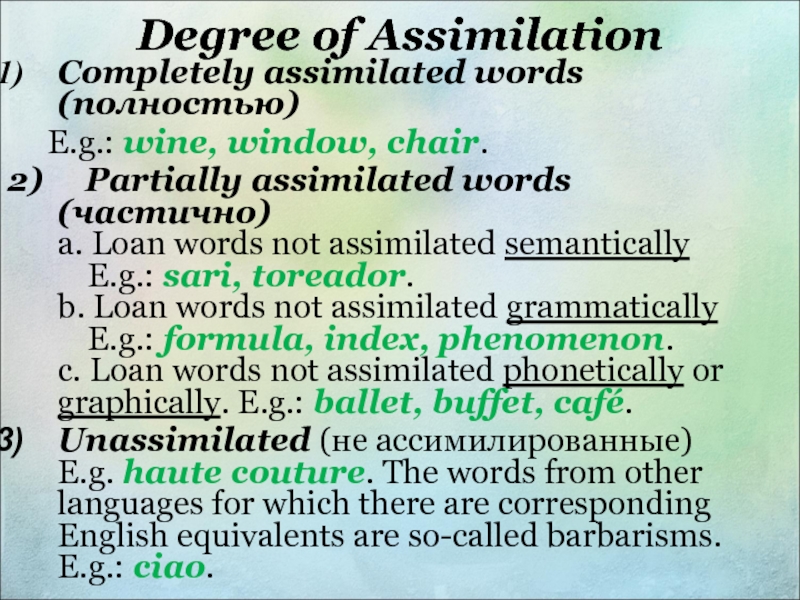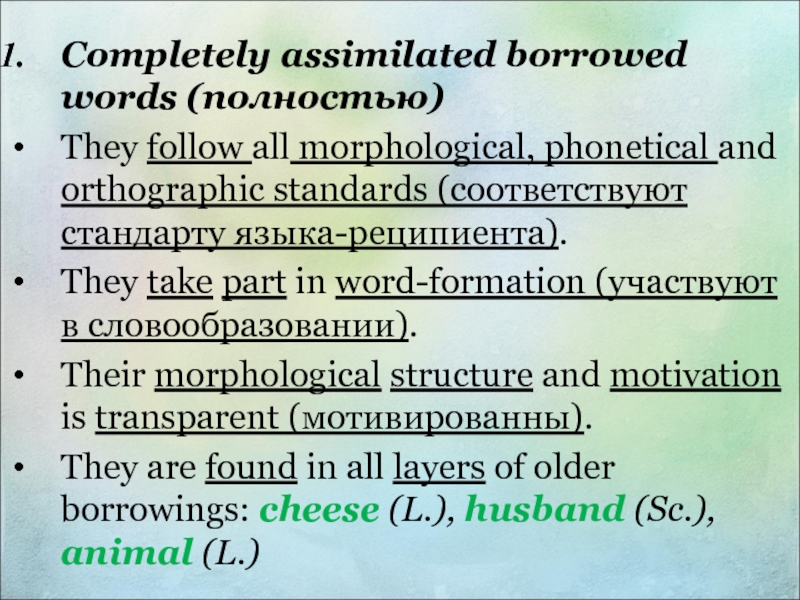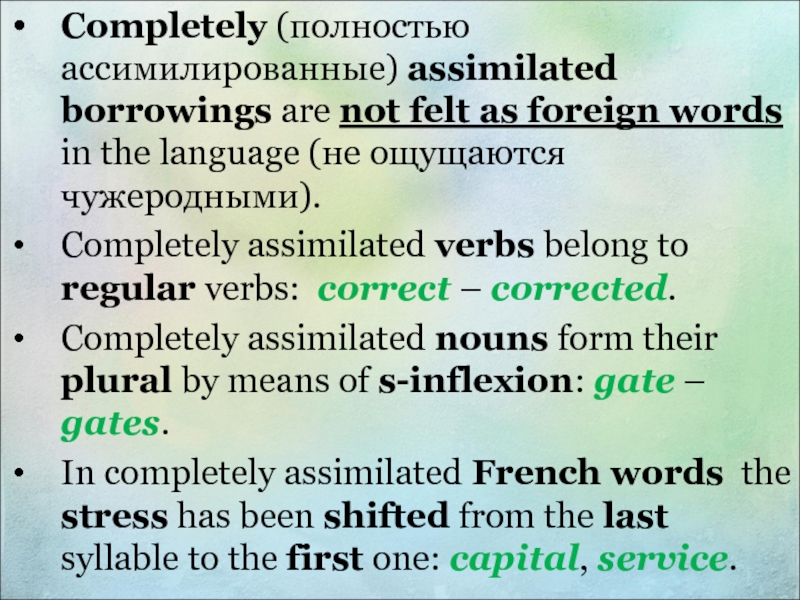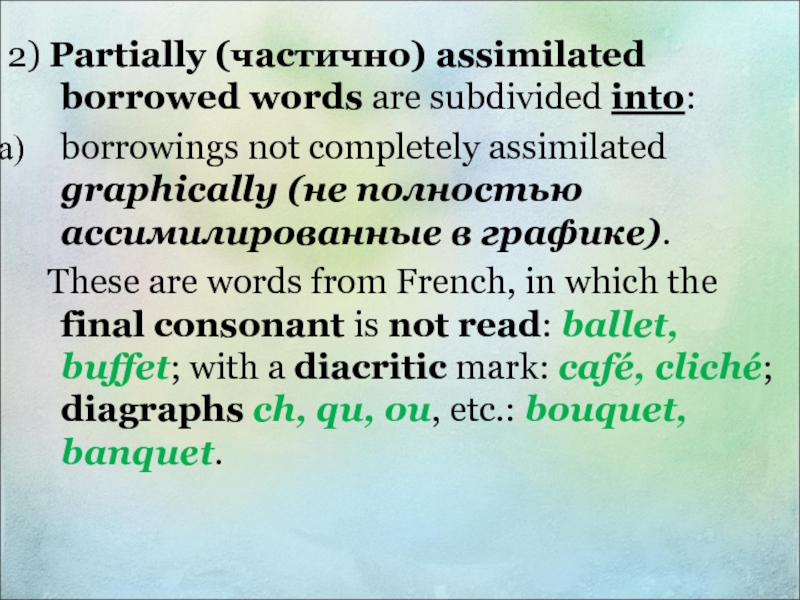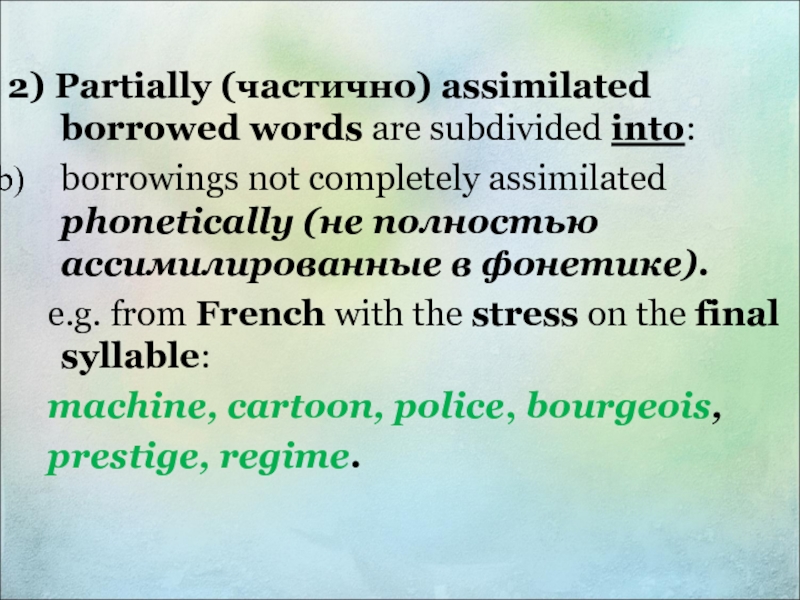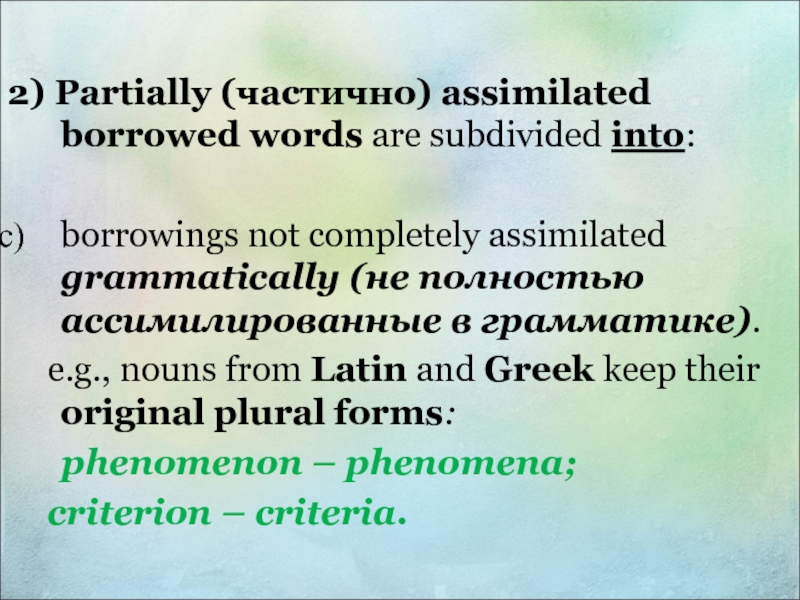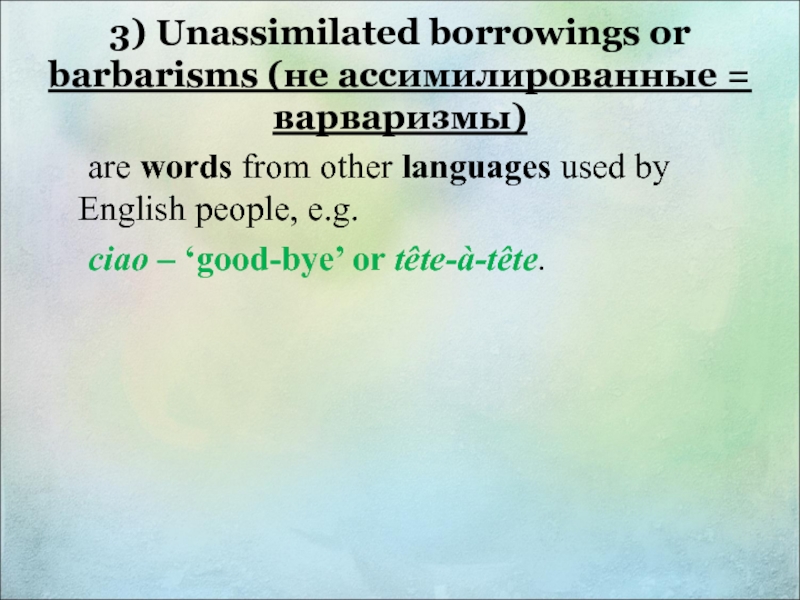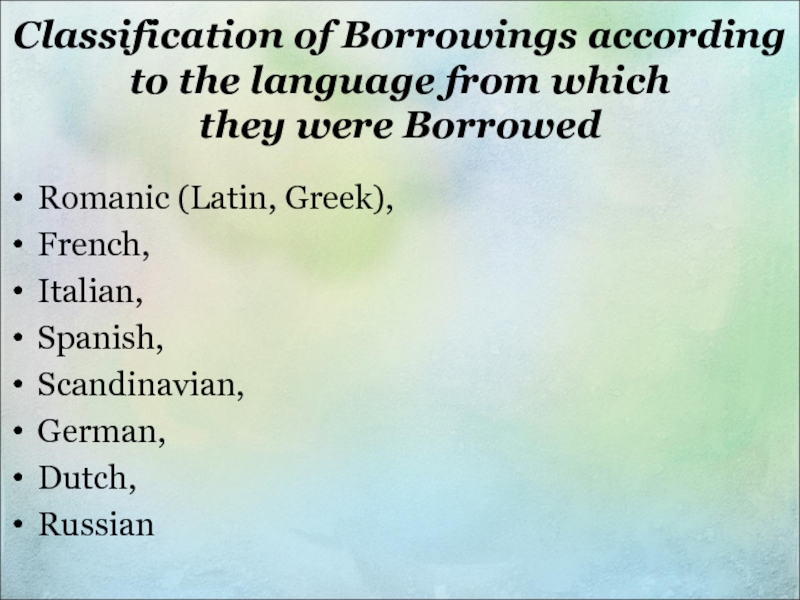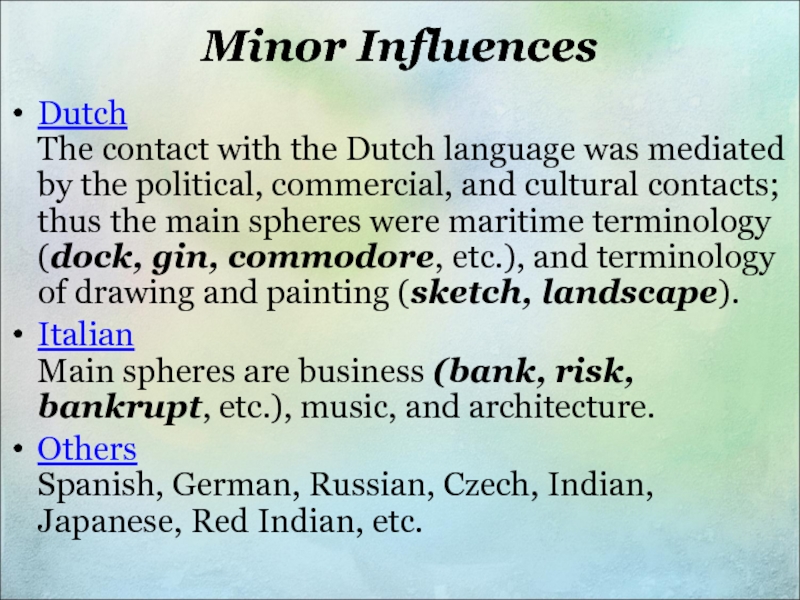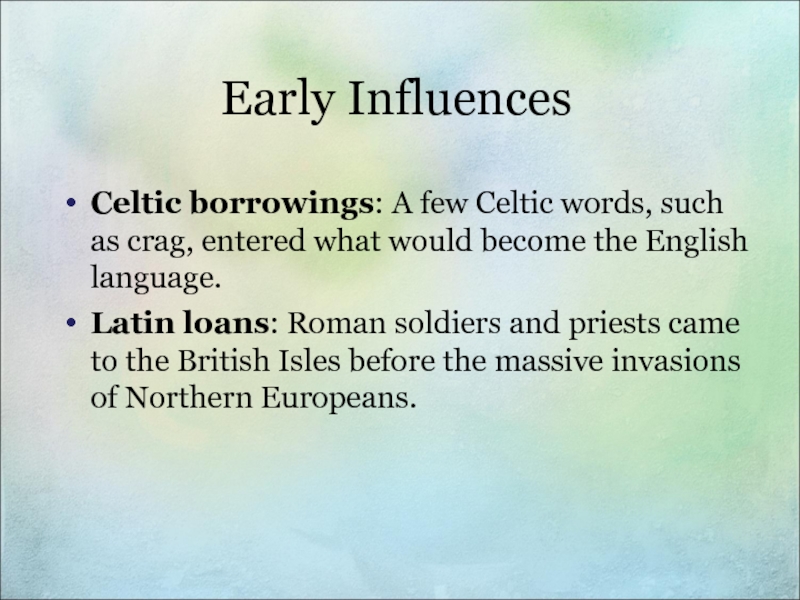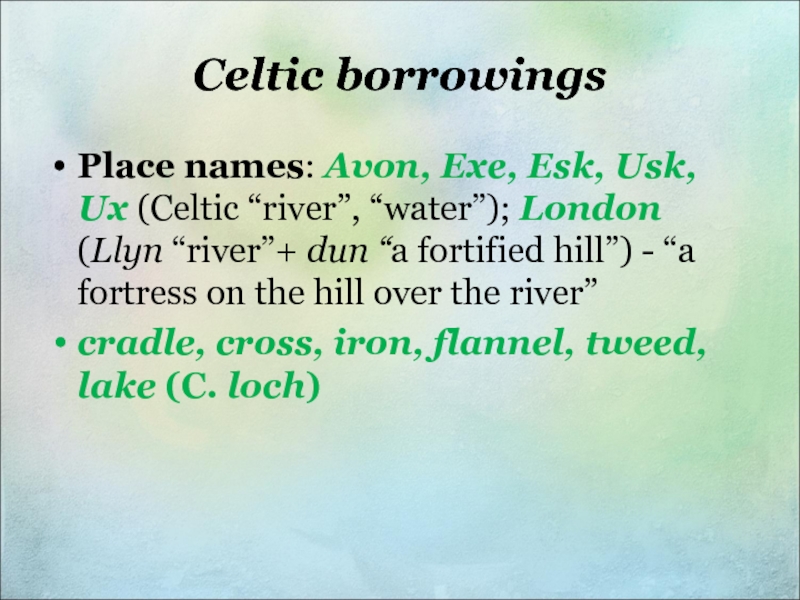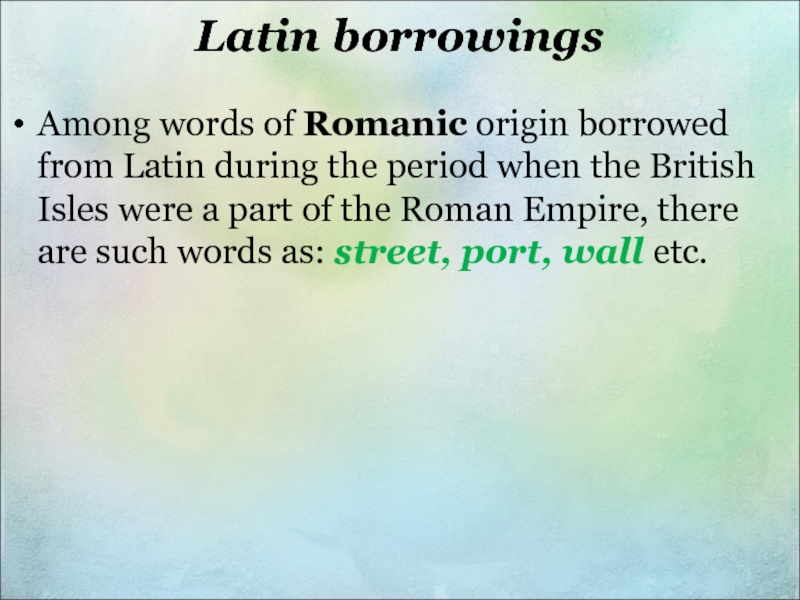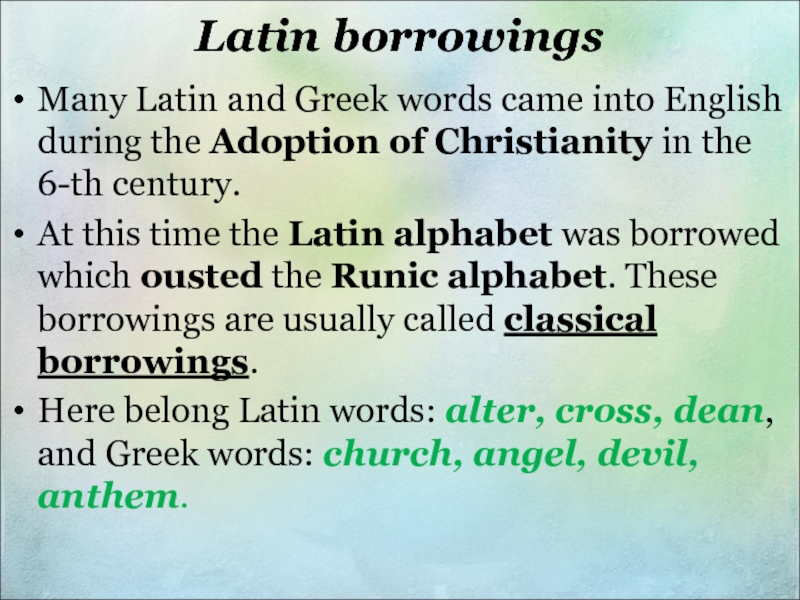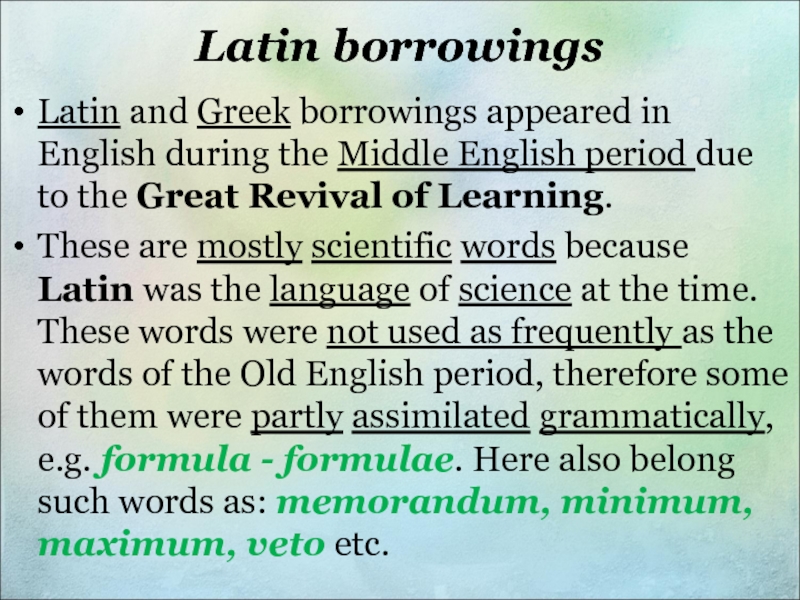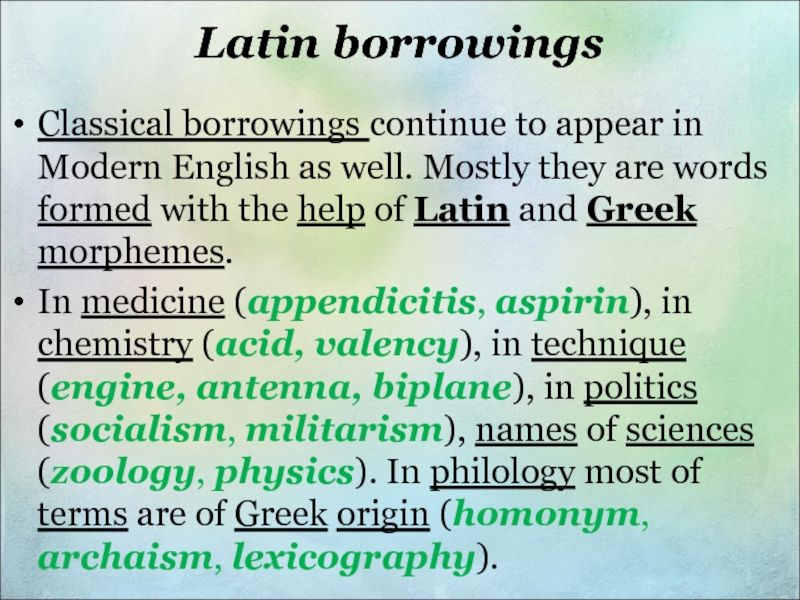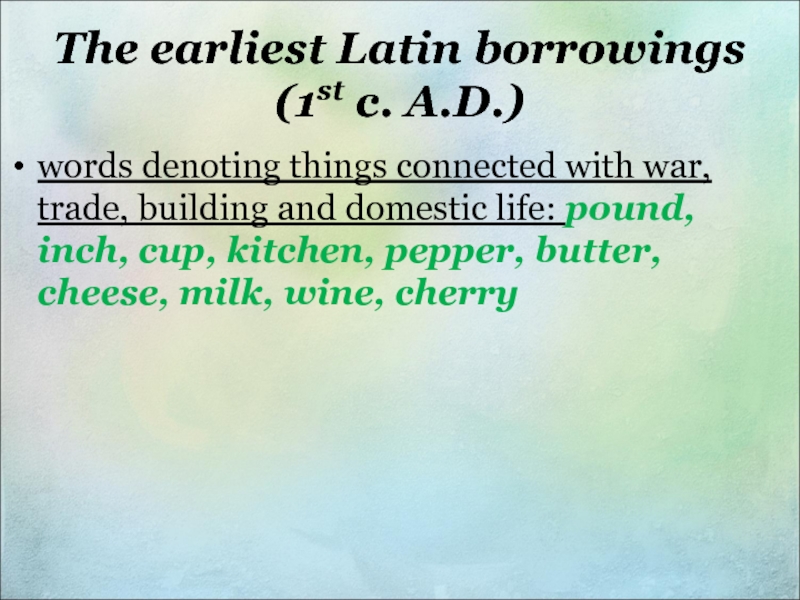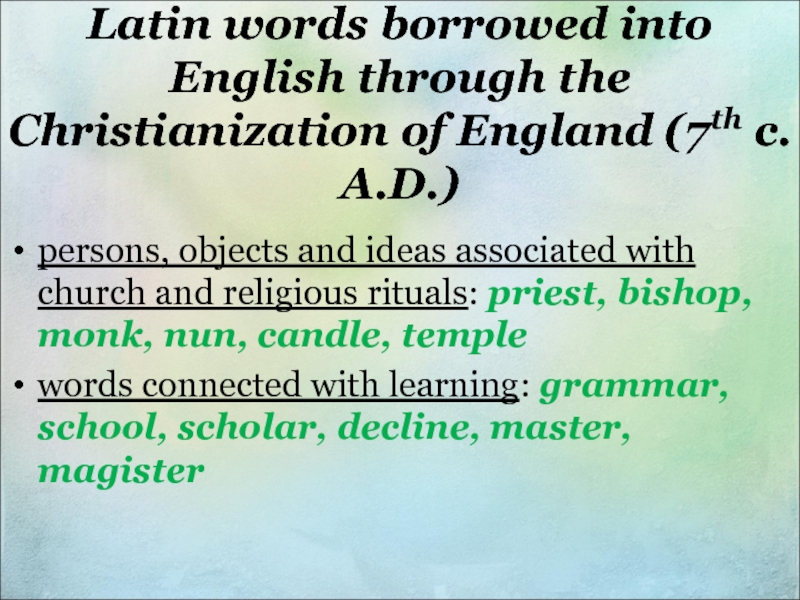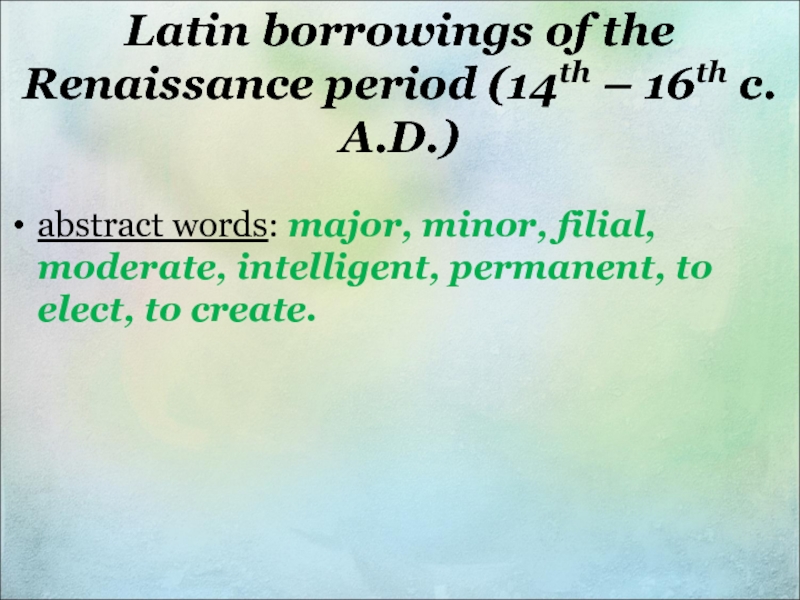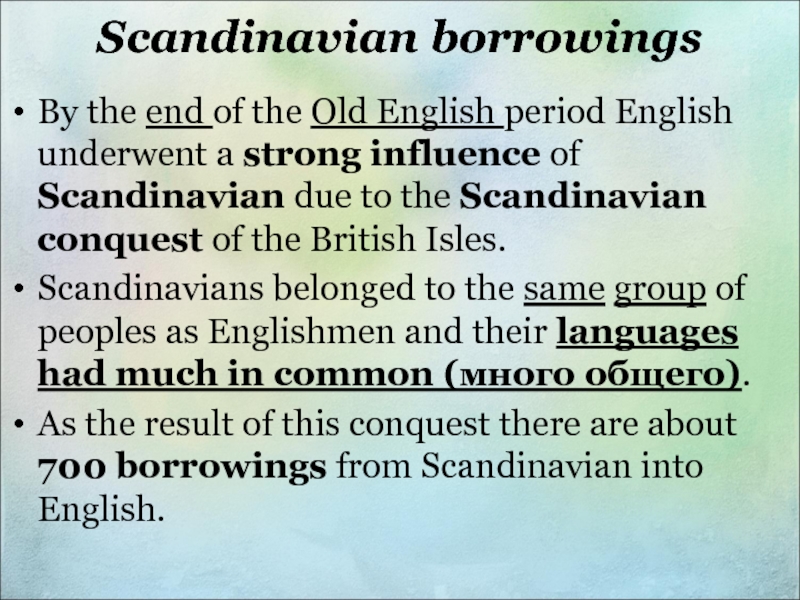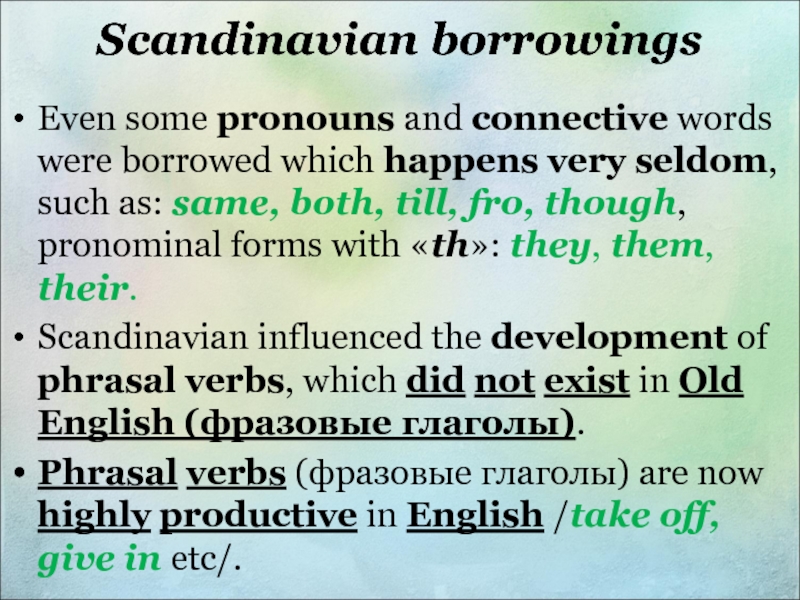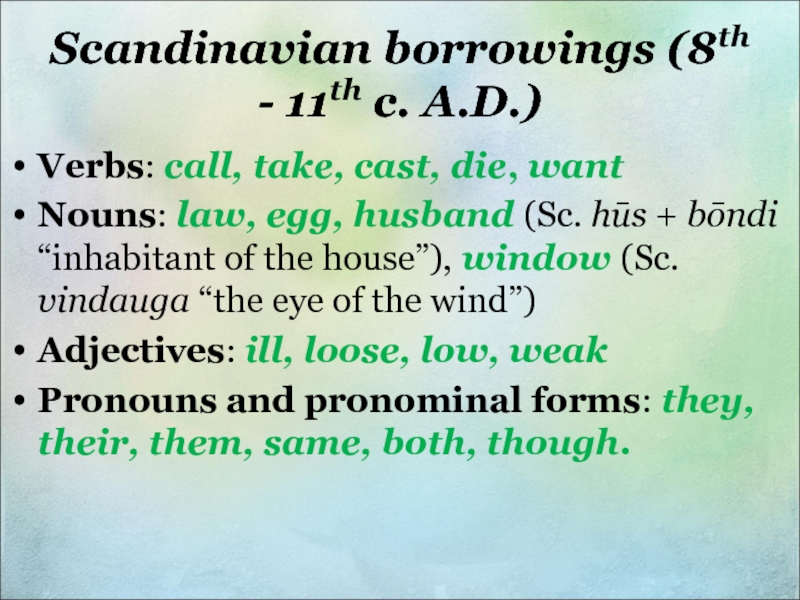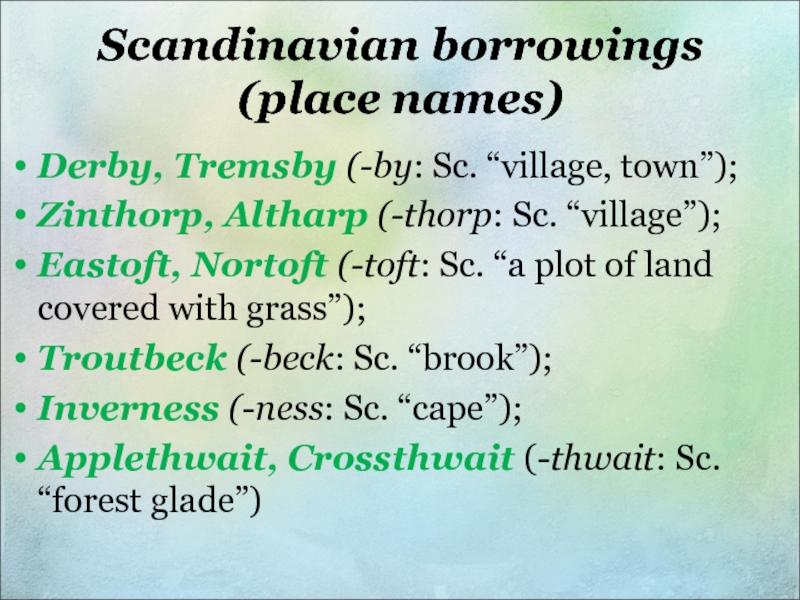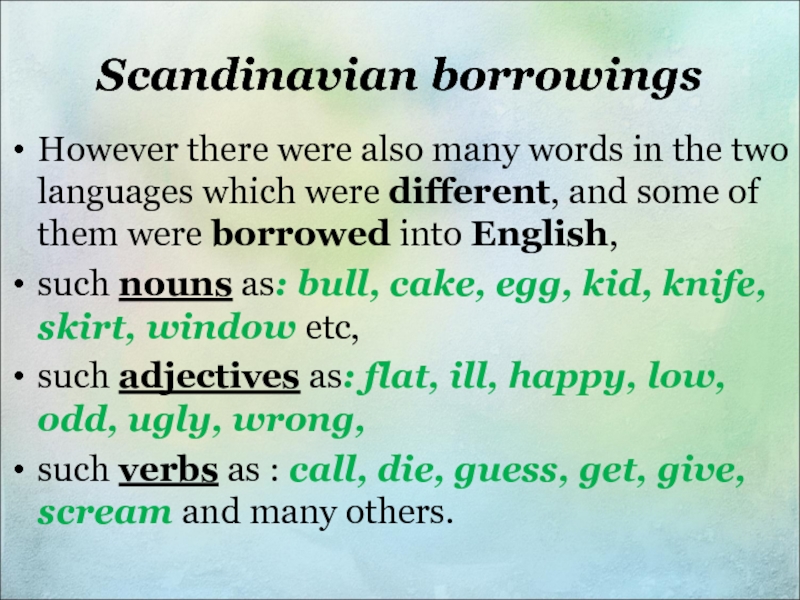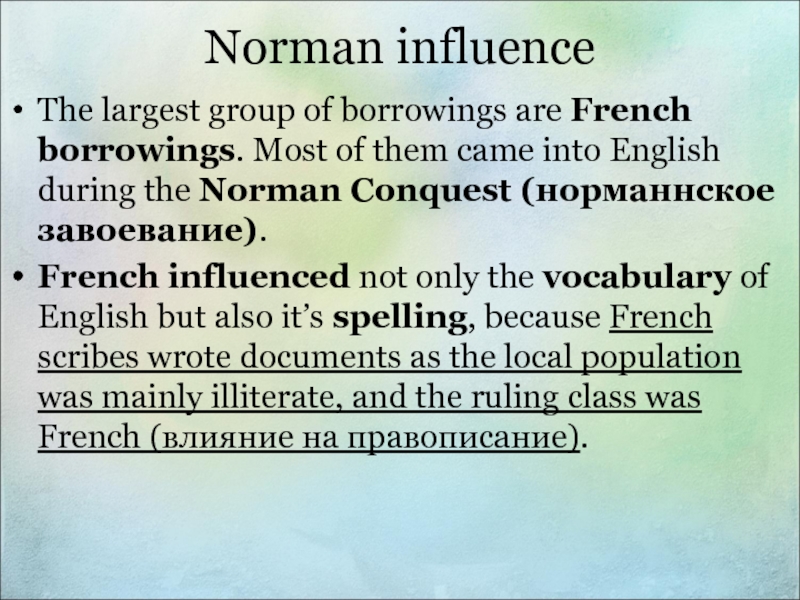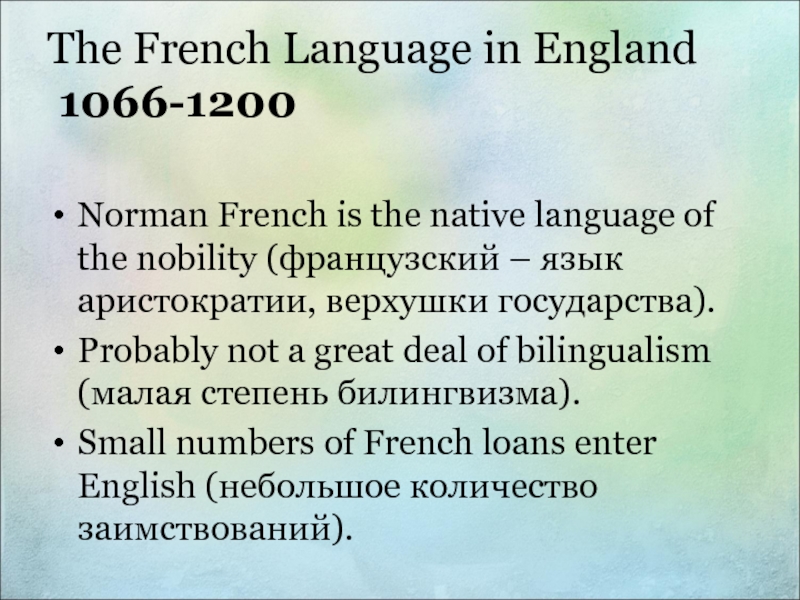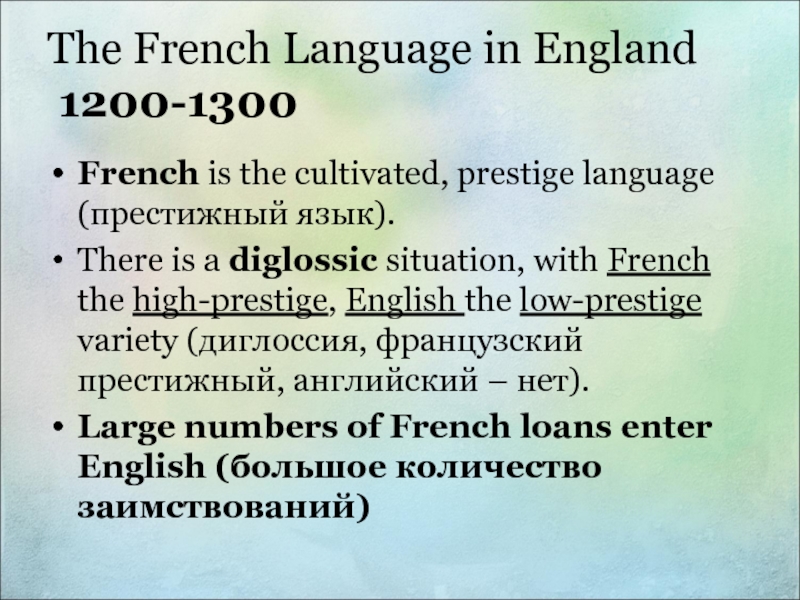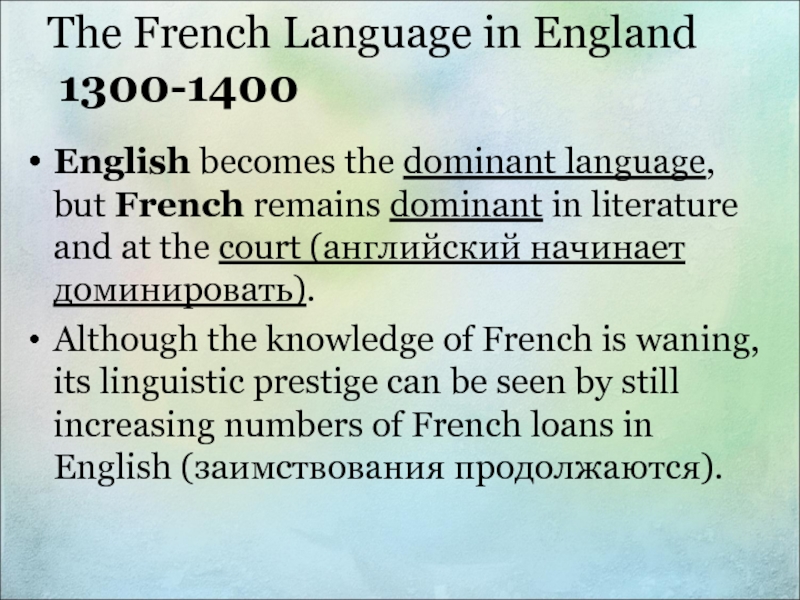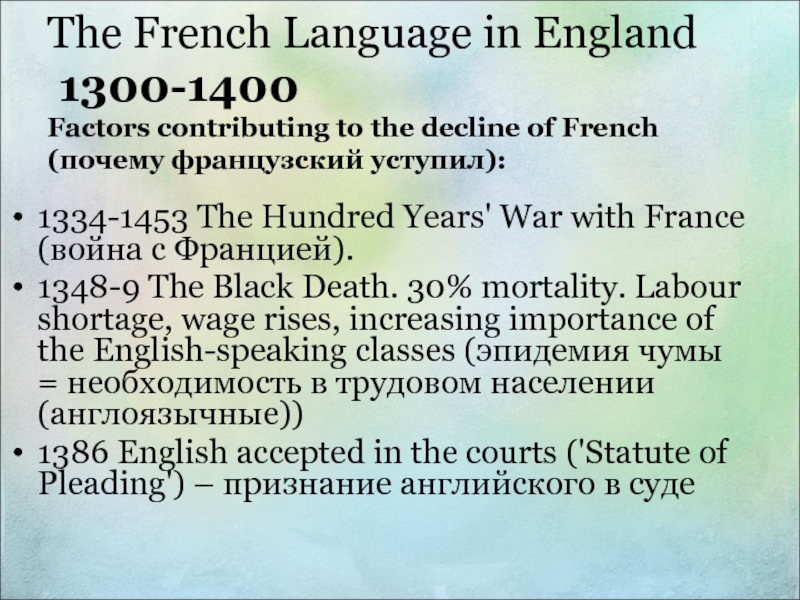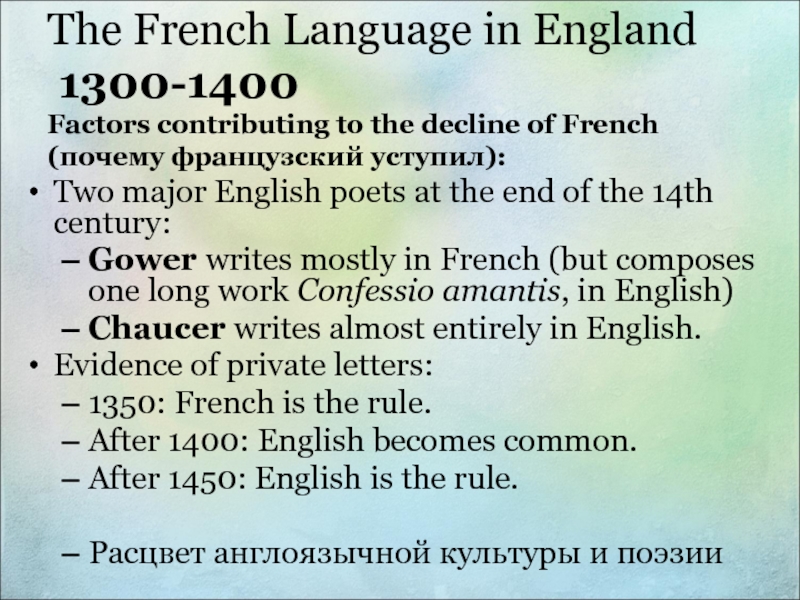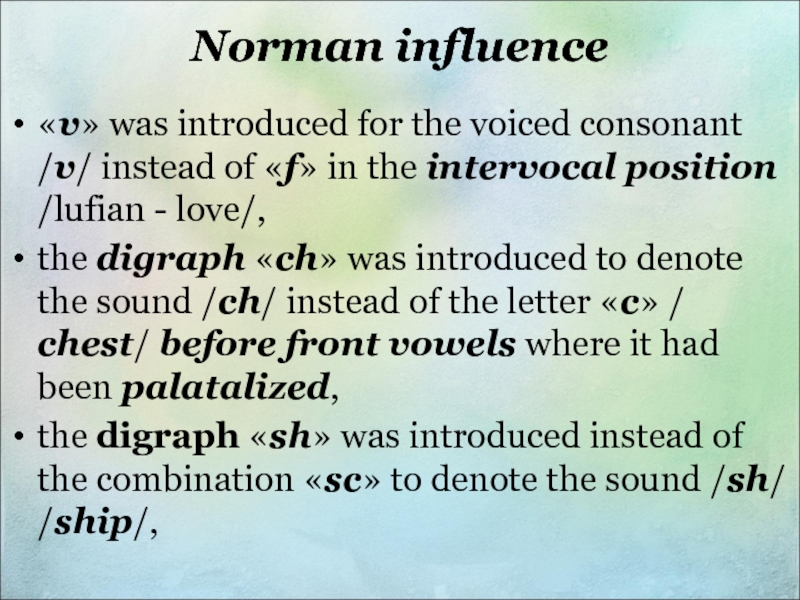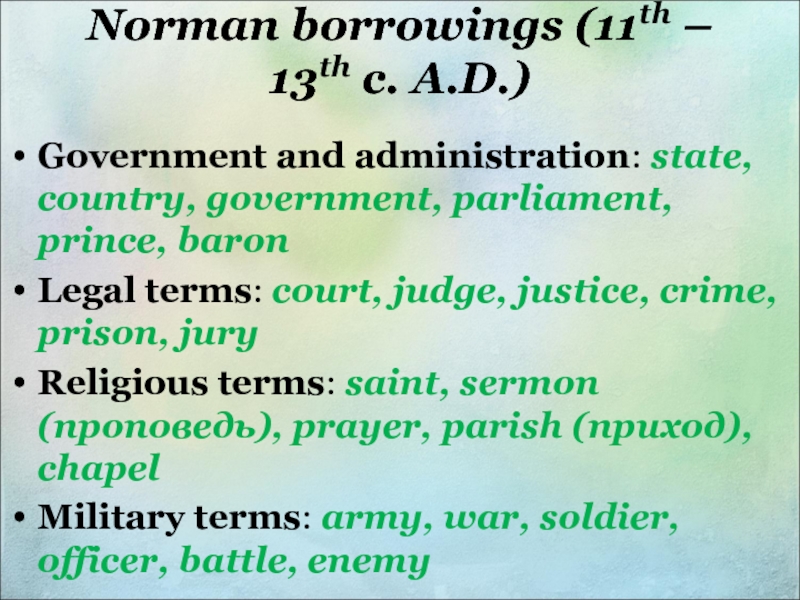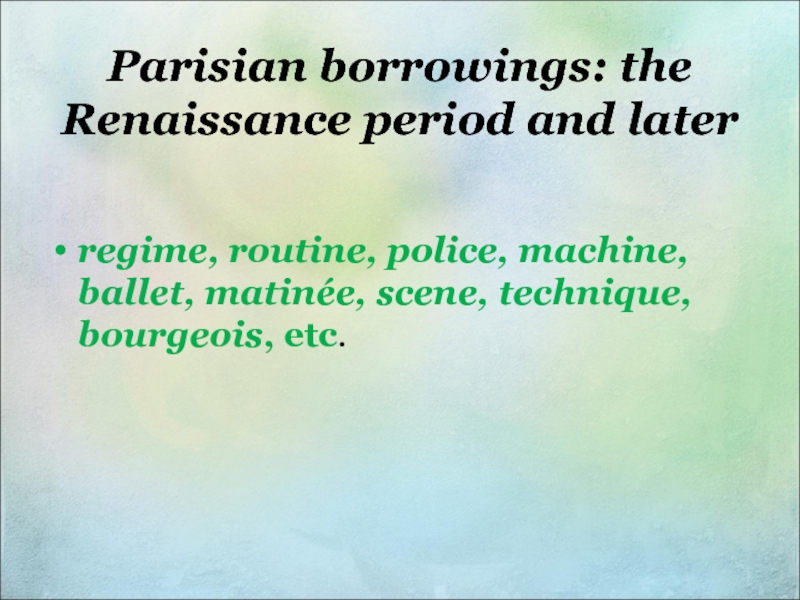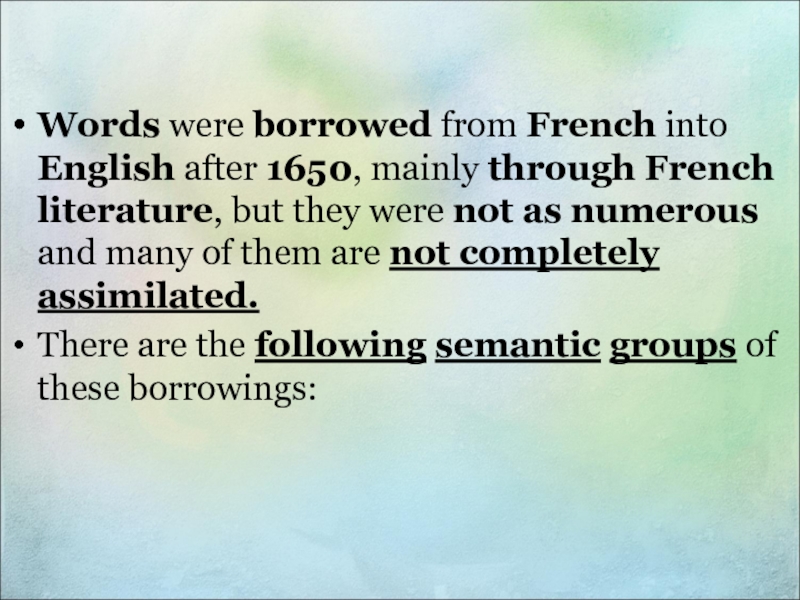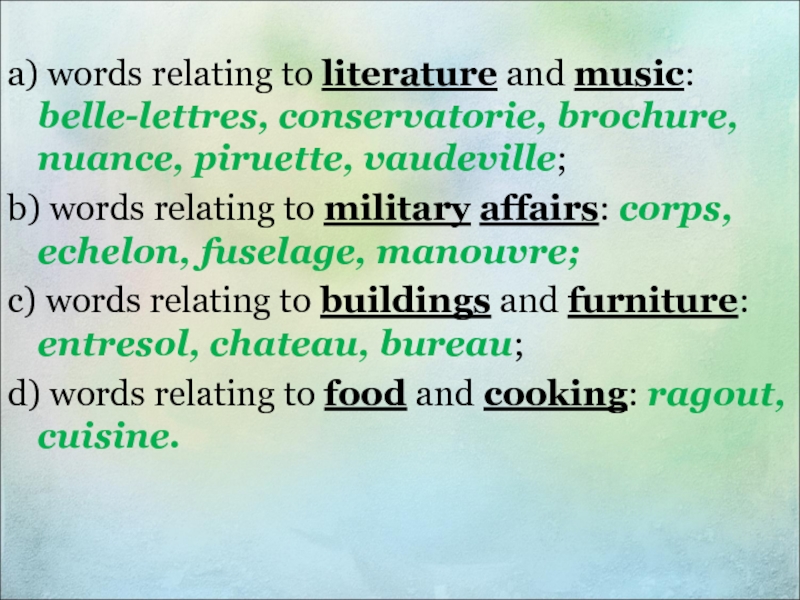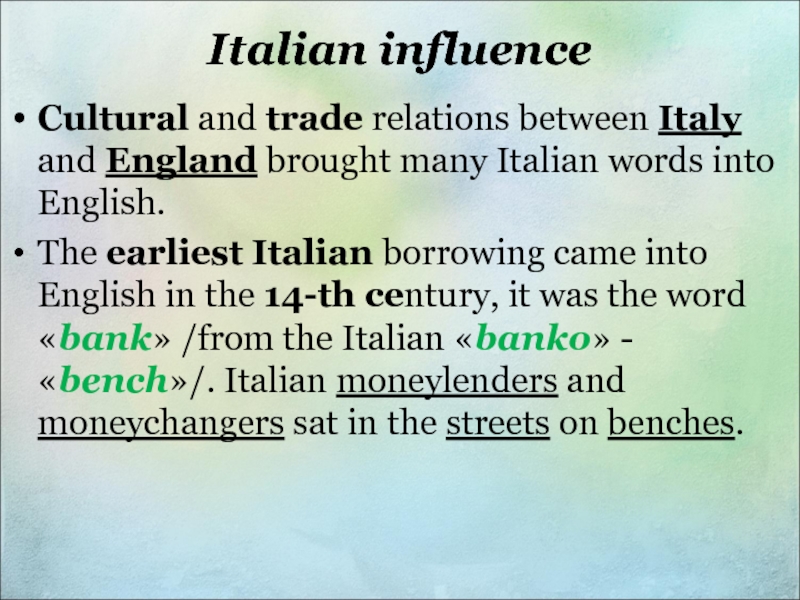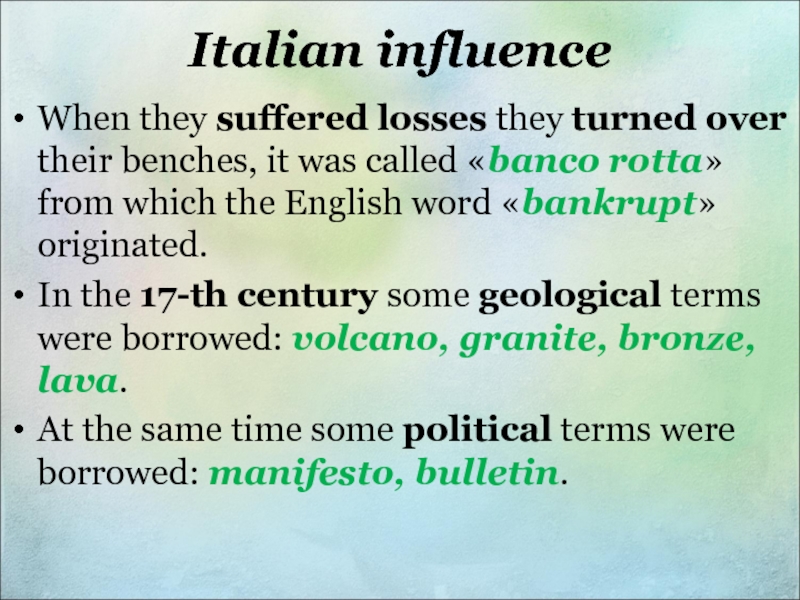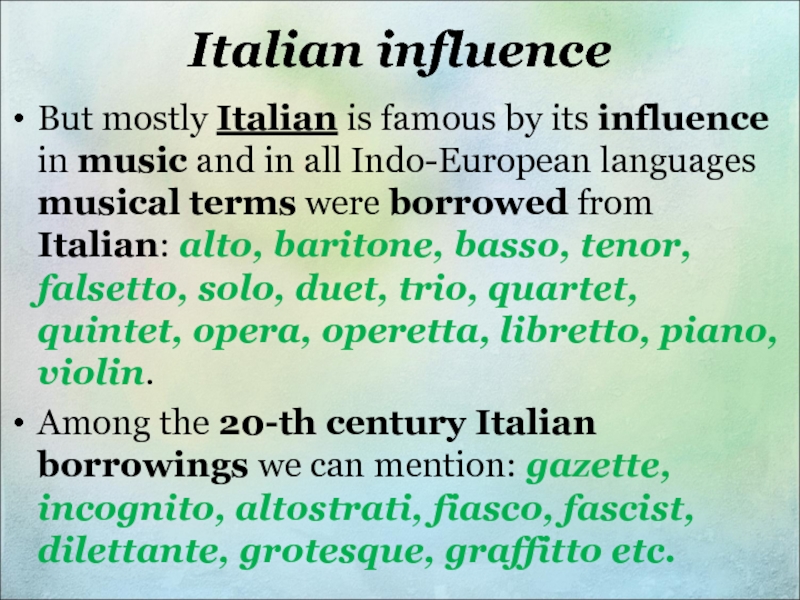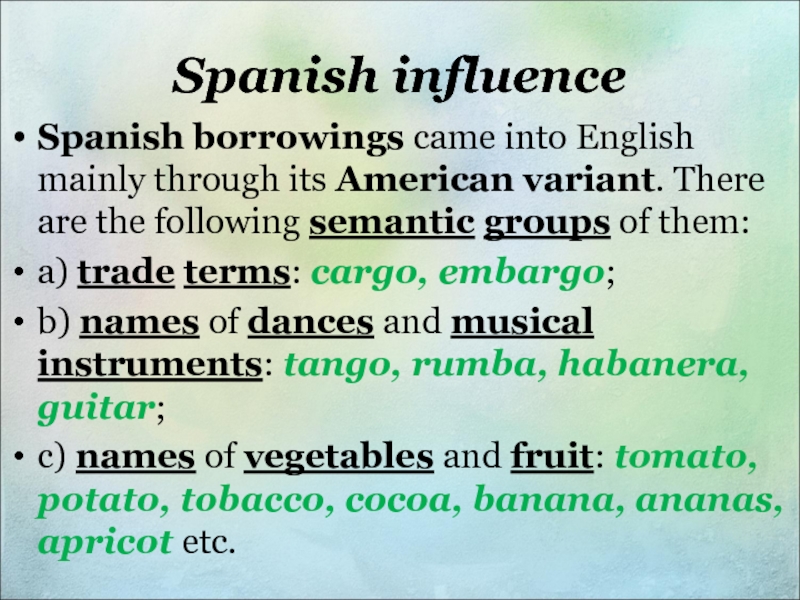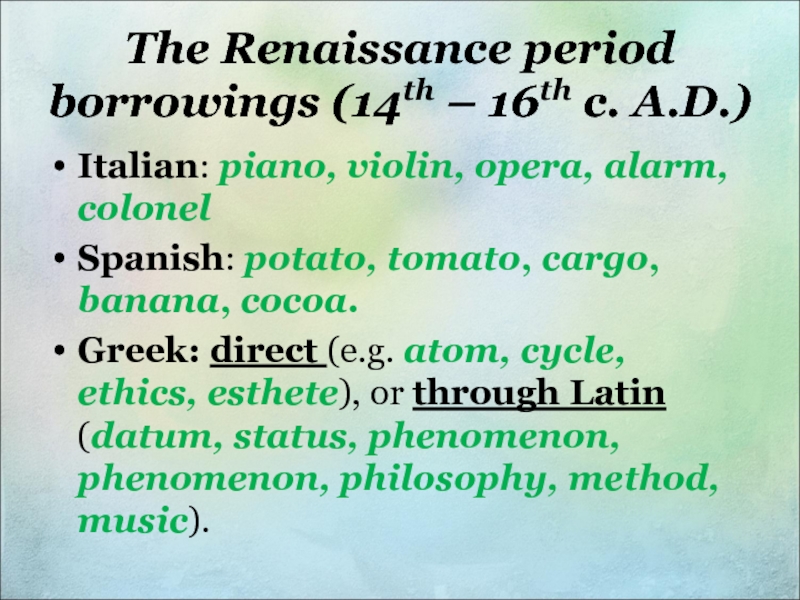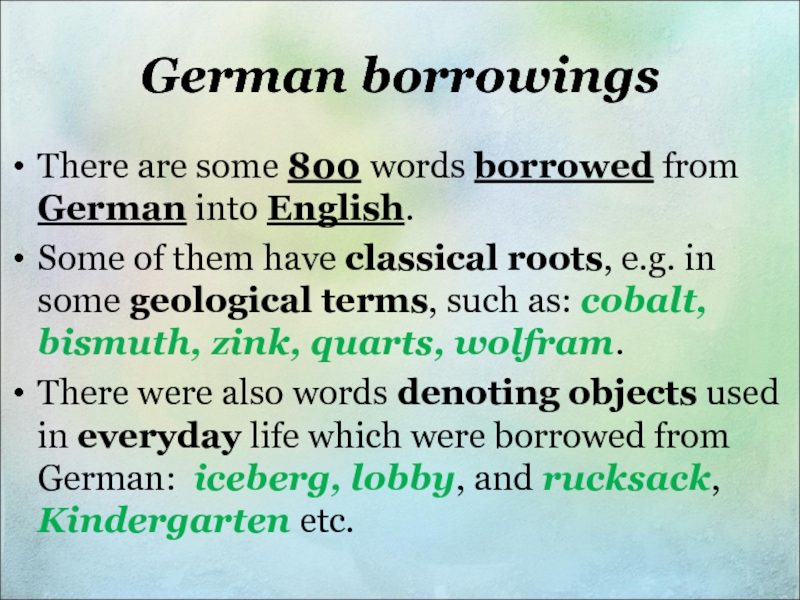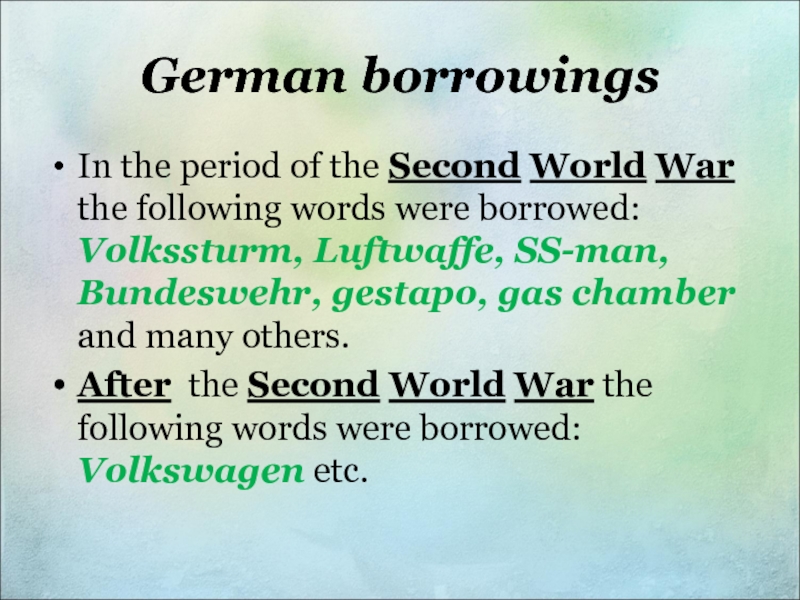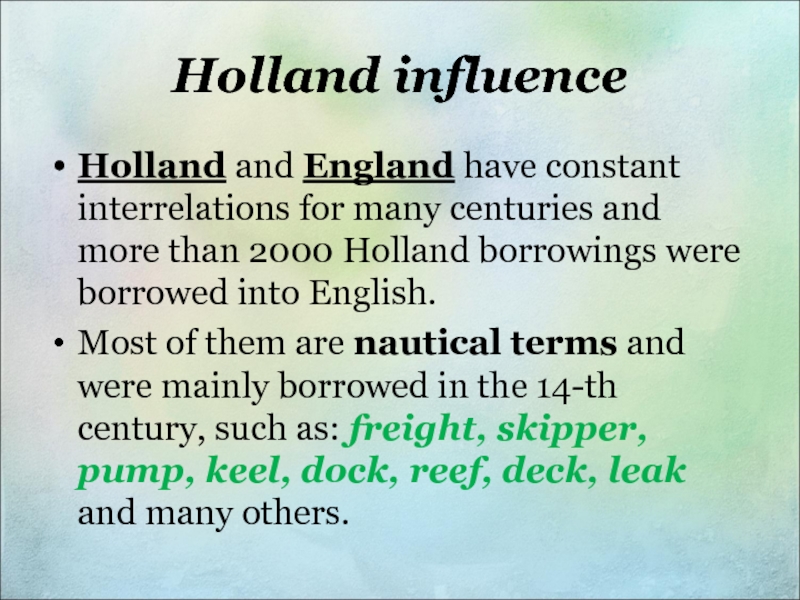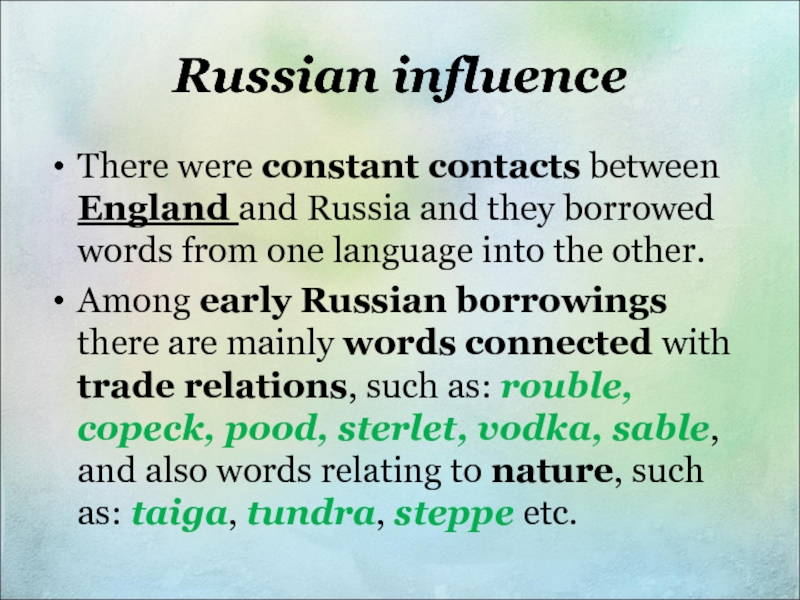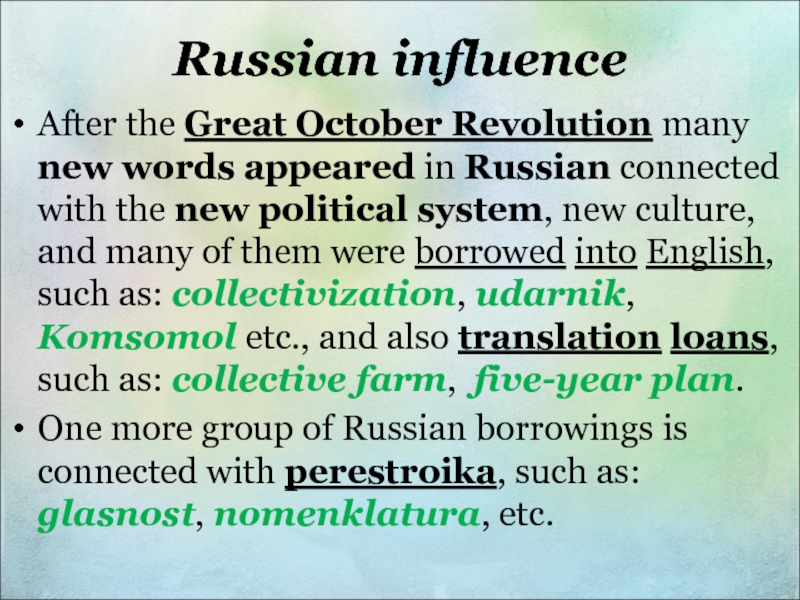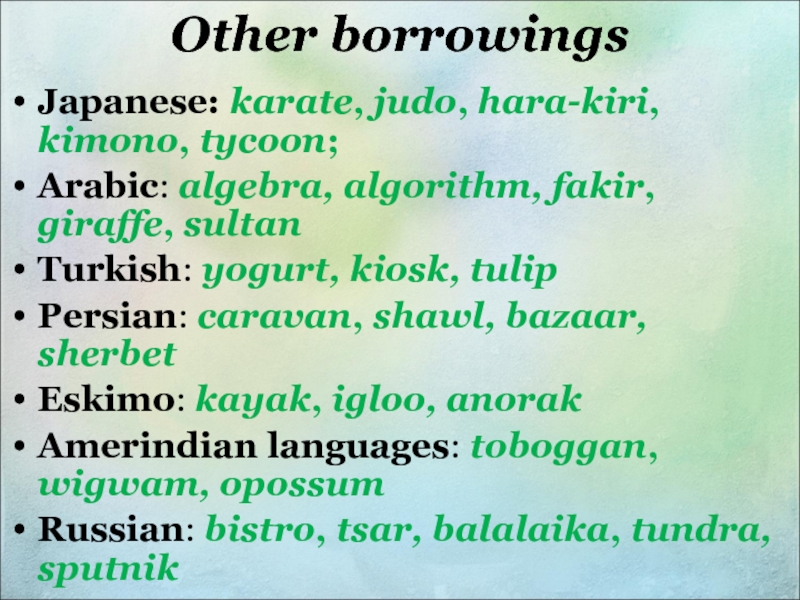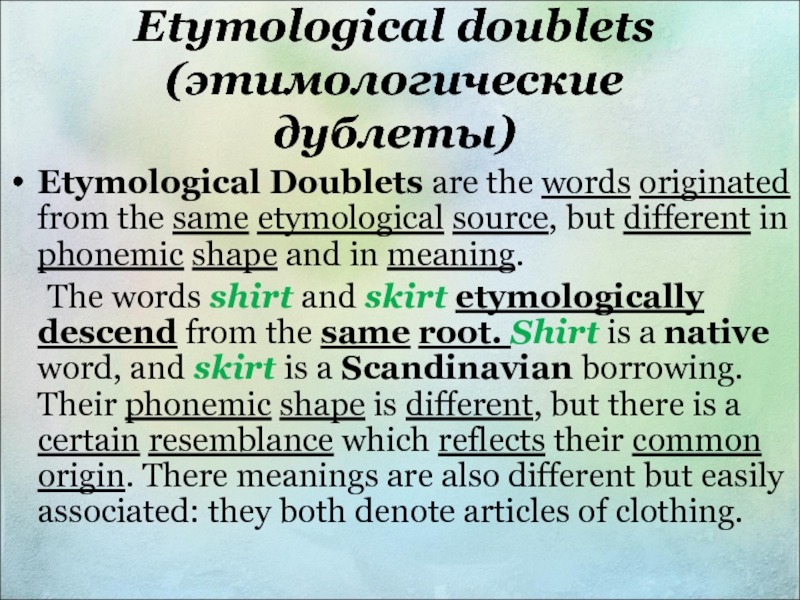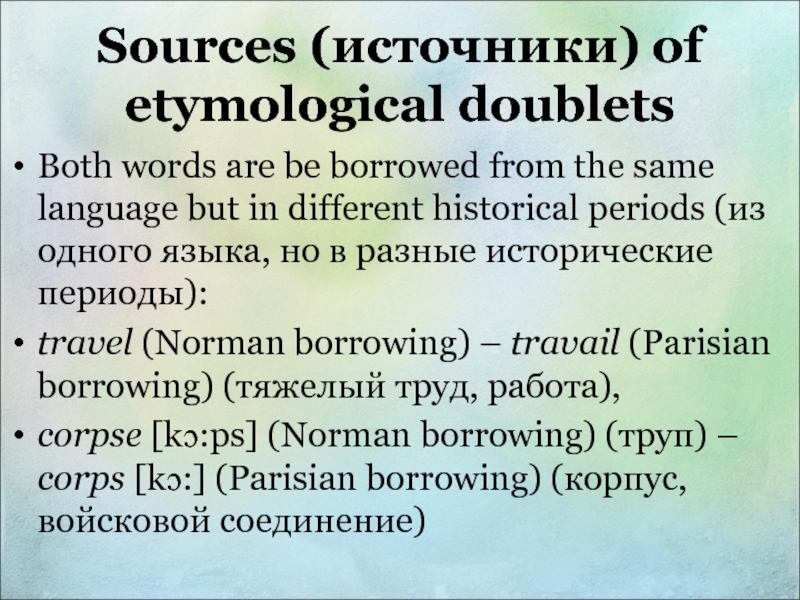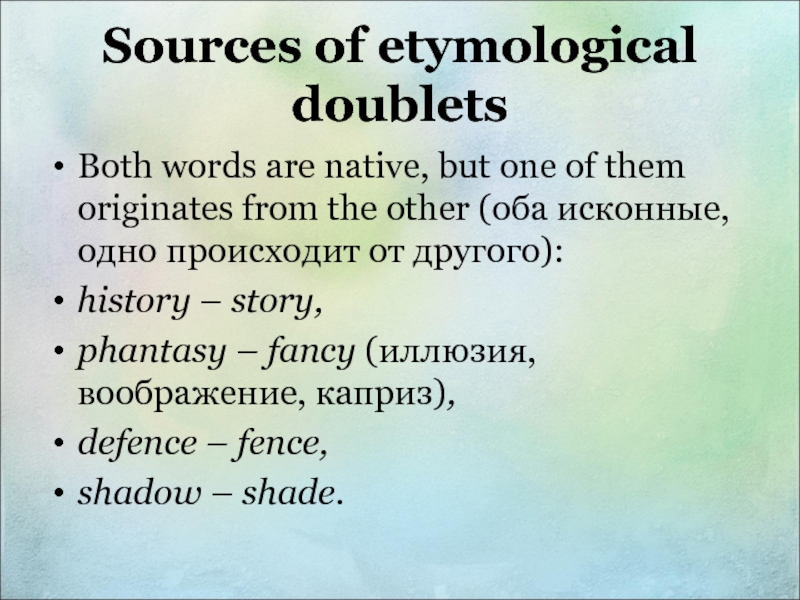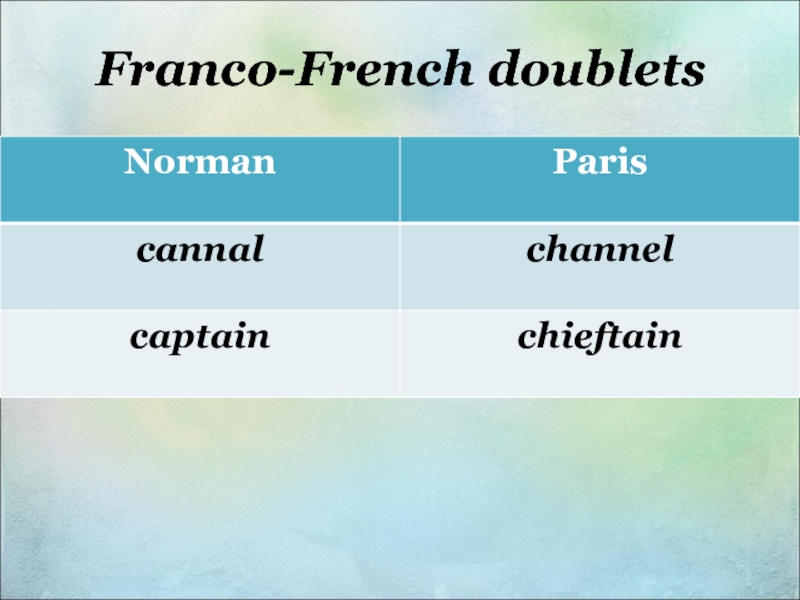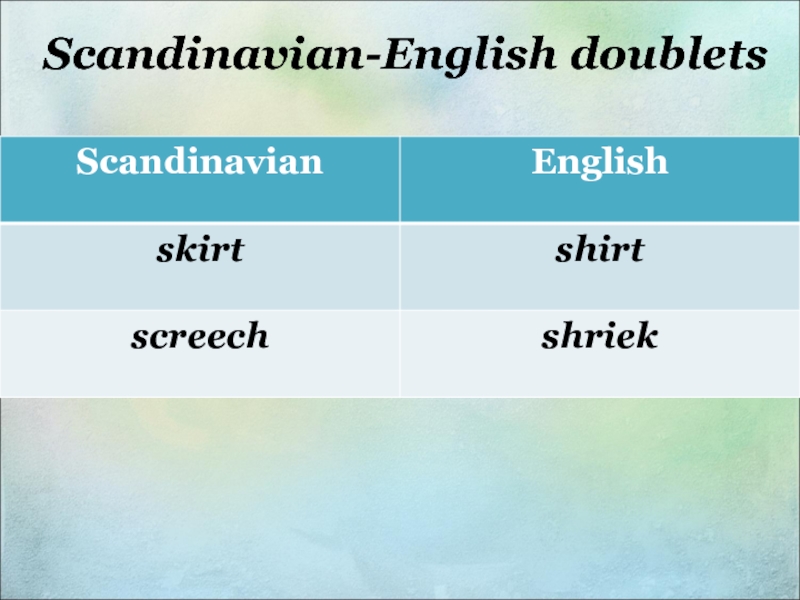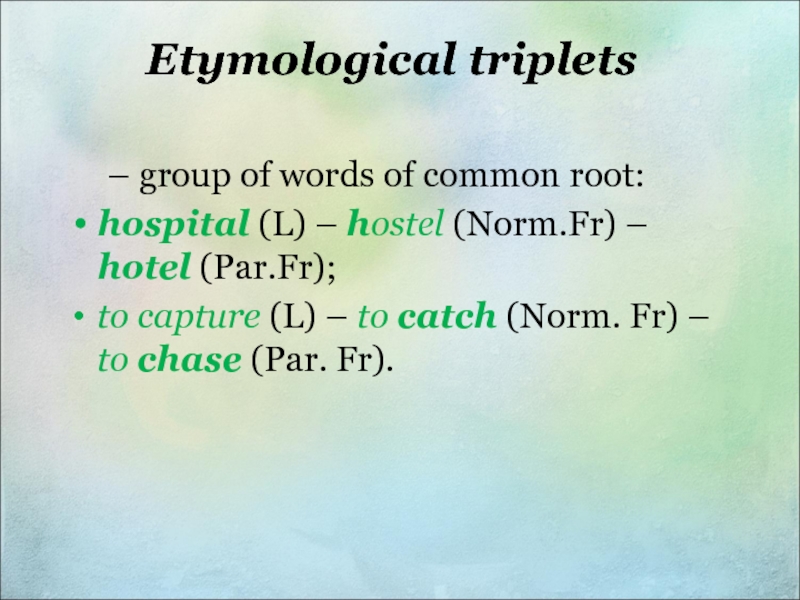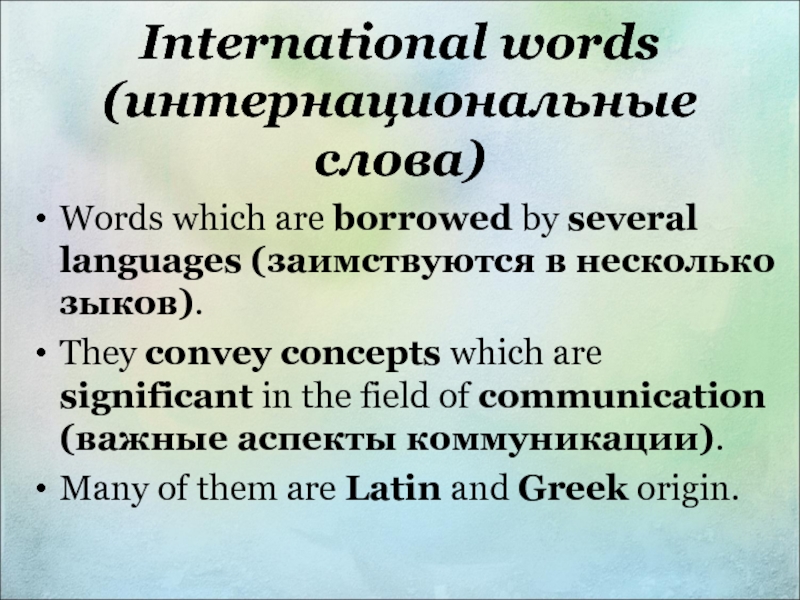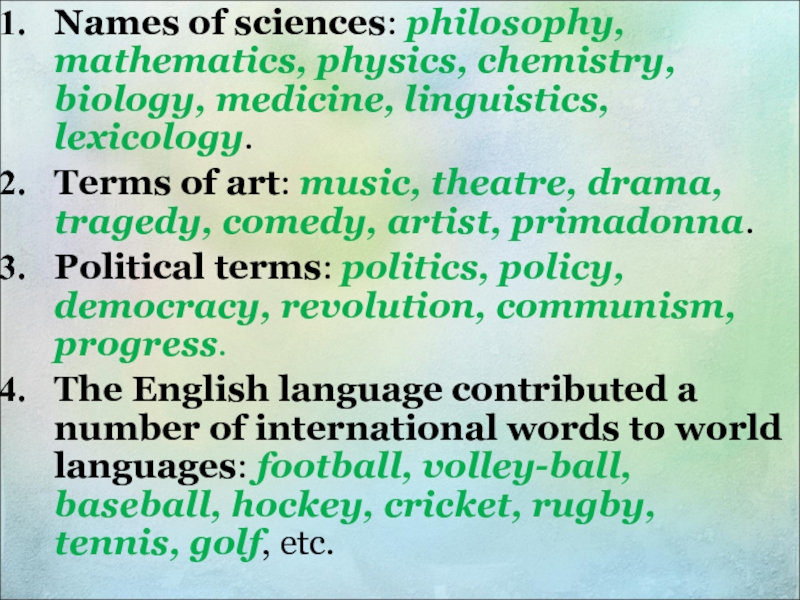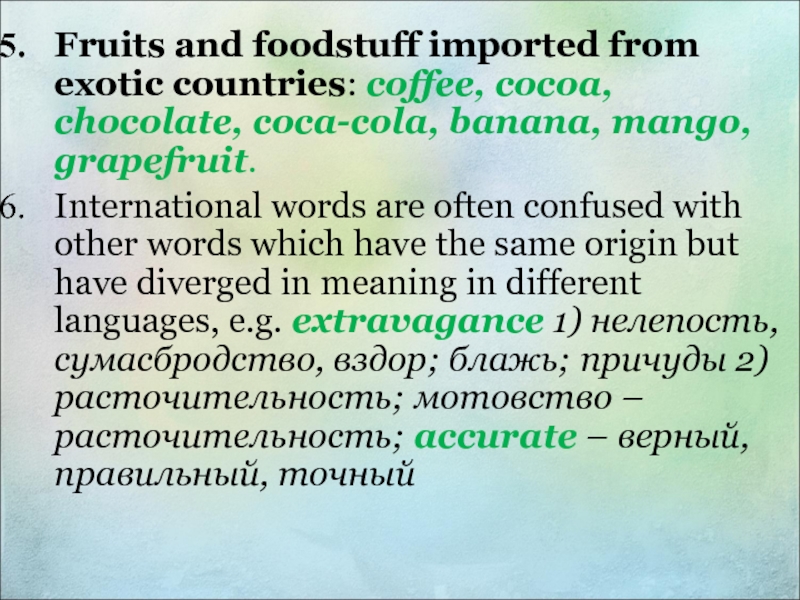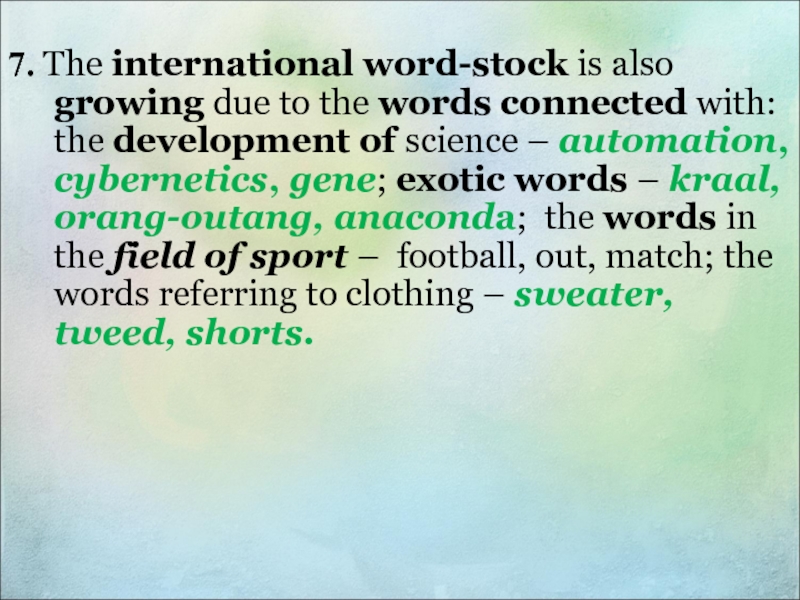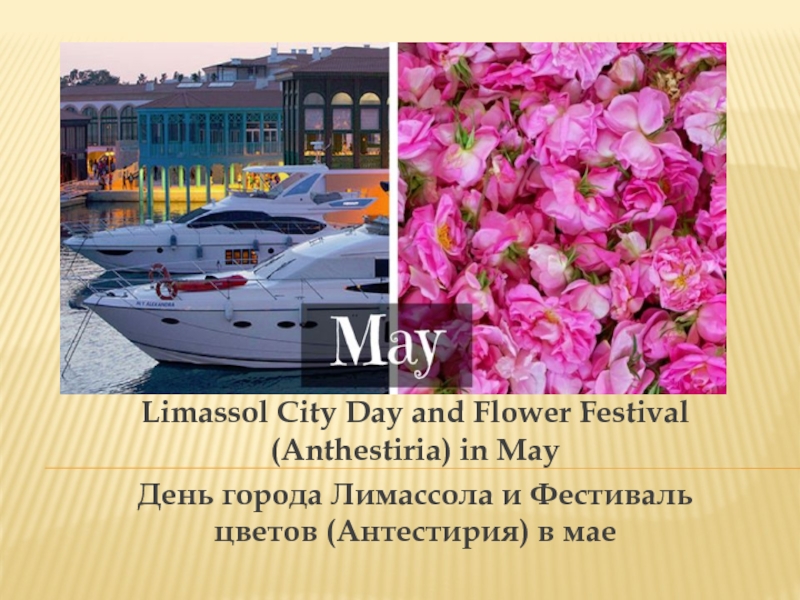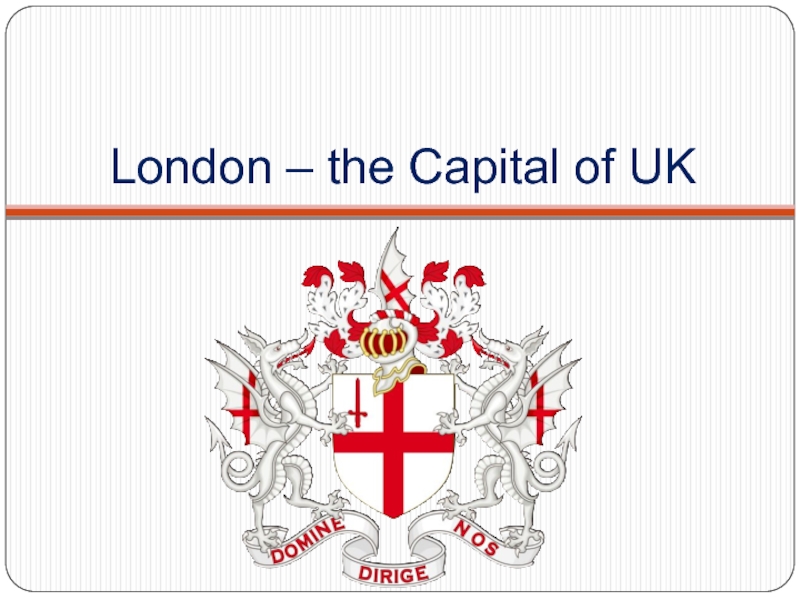- Главная
- Разное
- Дизайн
- Бизнес и предпринимательство
- Аналитика
- Образование
- Развлечения
- Красота и здоровье
- Финансы
- Государство
- Путешествия
- Спорт
- Недвижимость
- Армия
- Графика
- Культурология
- Еда и кулинария
- Лингвистика
- Английский язык
- Астрономия
- Алгебра
- Биология
- География
- Детские презентации
- Информатика
- История
- Литература
- Маркетинг
- Математика
- Медицина
- Менеджмент
- Музыка
- МХК
- Немецкий язык
- ОБЖ
- Обществознание
- Окружающий мир
- Педагогика
- Русский язык
- Технология
- Физика
- Философия
- Химия
- Шаблоны, картинки для презентаций
- Экология
- Экономика
- Юриспруденция
The basics of the English language (lexicology) презентация
Содержание
- 1. The basics of the English language (lexicology)
- 2. Lecture 9-10 – Etymology and borrowings
- 3. Etymology Отрасль лингвистики, изучающая исторические отношения между
- 4. Etymology of the English Word-stock Etymology
- 5. More than two thirds (Более 2/3) of
- 7. The Origins of English Words
- 8. Definitions A native word (исконное слово)
- 9. Исконные слова (индоевропейские): kinship terms (термины родства):
- 10. 5. concrete physical properties and qualities (основные
- 11. Words of the common Germanic origin (слова
- 12. parts of the human body (части тела):
- 13. abstract notions (абстрактные понятия): care, evil, hope,
- 14. Характеристики исконных слов Высокая степень сочетаемости,
- 15. Исторические причины заимствований Римское завоевание (1st c.
- 16. The Etymology of Borrowed Words
- 17. The Etymology of Borrowed Words
- 18. a number of Scandinavian borrowings were felt
- 19. Some of the words of this group
- 20. Пути заимствования Borrowings enter the language
- 21. Borrowings enter the language in 2 ways:
- 22. Классификация заимствований Borrowings can be classified according
- 23. Первый критерий – аспект заимствования There are
- 24. Phonetic borrowings Самые частотные во всех
- 25. Phonetic borrowings The position of the
- 26. Translation borrowings (калька) Words and expressions formed
- 27. Semantic borrowing (семантическое заимствование) It is understood
- 28. Other types of borrowings word coins (производные)
- 29. Assimilation of borrowings denotes a partial or
- 30. The degree of assimilation (степень ассимиляции)
- 31. The degree of assimilation of
- 32. Degree of Assimilation Completely assimilated words (полностью)
- 33. Completely assimilated borrowed words (полностью) They follow
- 34. Completely (полностью ассимилированные) assimilated borrowings are not
- 35. 2) Partially (частично) assimilated borrowed words are
- 36. 2) Partially (частично) assimilated borrowed words are
- 37. 2) Partially (частично) assimilated borrowed words are
- 38. 2) Partially assimilated borrowed words are subdivided
- 39. 3) Unassimilated borrowings or barbarisms (не ассимилированные
- 40. Classification of Borrowings according to the language
- 41. Major Influences Celtic - the number of
- 42. Minor Influences Dutch The contact with the
- 43. Early Influences Celtic borrowings: A few Celtic
- 44. Celtic borrowings Place names: Avon, Exe,
- 45. Latin borrowings Among words of Romanic origin
- 46. Latin borrowings Many Latin and Greek words
- 47. Latin borrowings Latin and Greek borrowings appeared
- 48. Latin borrowings Classical borrowings continue to appear
- 49. The earliest Latin borrowings (1st c. A.D.)
- 50. Latin words borrowed into English through
- 51. Latin borrowings of the Renaissance period (14th
- 52. Scandinavian borrowings By the end of the
- 53. Scandinavian borrowings Even some pronouns and connective
- 54. Scandinavian borrowings (8th - 11th c. A.D.)
- 55. Scandinavian borrowings (place names)
- 56. Scandinavian borrowings However there were also many
- 57. Norman influence The largest group of borrowings
- 58. The French Language in England 1066-1200
- 59. French is the cultivated, prestige language (престижный
- 60. English becomes the dominant language, but French
- 61. 1334-1453 The Hundred Years' War with France
- 62. Two major English poets at the end
- 63. Norman influence «v» was introduced for the
- 64. Norman influence the digraph «th» was introduced
- 65. Norman influence the digraph «ou» was introduced
- 66. Norman borrowings (11th – 13th c. A.D.)
- 67. Norman borrowings (11th – 13th c. A.D.)
- 68. English-French Pairs Sheep-mutton Calf-veal Deer-venison Pig-pork Begin-commence
- 69. Parisian borrowings: the Renaissance period and later
- 70. Words were borrowed from French
- 71. a) words relating to literature and music:
- 72. Italian influence Cultural and trade relations between
- 73. Italian influence When they suffered losses they
- 74. Italian influence But mostly Italian is famous
- 75. Spanish influence Spanish borrowings came into English
- 76. The Renaissance period borrowings (14th – 16th
- 77. German borrowings There are some 800 words
- 78. German borrowings In the period of the
- 79. Holland influence Holland and England have constant
- 80. Russian influence There were constant contacts between
- 81. Russian influence There is also a large
- 82. Russian influence After the Great October Revolution
- 83. Other borrowings Japanese: karate, judo, hara-kiri, kimono,
- 84. Etymological doublets (этимологические дублеты) Etymological Doublets are
- 85. Sources of etymological doublets Native word +
- 86. Sources (источники) of etymological doublets Both words
- 87. Sources of etymological doublets Both words are
- 88. Latino-French doublets
- 89. Franco-French doublets
- 90. Scandinavian-English doublets
- 91. Etymological triplets – group of words of
- 92. Words which are borrowed by several
- 93. Names of sciences: philosophy, mathematics, physics, chemistry,
- 94. Fruits and foodstuff imported from exotic countries:
- 95. 7. The international word-stock is also growing
Слайд 1The basics of the English language (lexicology)
Сандалова Н.В
к.ф.н., ст. преп.
каф.
сопоставительного языкознания,
УрГПУ
natalia-sandalova@yandex.ru
Слайд 2
Lecture 9-10 – Etymology and borrowings
Plan:
Etymology
Native words
Borrowed words
Assimilation of borrowings
Sources and
Etymological doublets and International words
Слайд 3Etymology
Отрасль лингвистики, изучающая исторические отношения между словом и более ранними формами
Слайд 4Etymology of the English Word-stock
Etymology (Gr. etymon “truth” + Gr. logos
Слайд 5More than two thirds (Более 2/3) of the English vocabulary are
Borrowed words are different from native ones by their phonetic structure, by their morphological structure and also by their grammatical forms.
English history is very rich in different types of contacts with other countries, that is why it is very rich in borrowings.
Слайд 8Definitions
A native word (исконное слово) is a word which belongs
A borrowed word (a borrowing, or a loan word, заимствование) is a word taken over from another language and modified in phonemic shape, spelling, paradigm or meaning according to the standards of the English language (полностью или частично модифицированное по стандартам АЯ).
Слайд 9Исконные слова (индоевропейские):
kinship terms (термины родства): mother, father, son, daughter, brother;
important
animals and plants (некоторые растения и животные): goose, wolf, cow, tree, corn;
parts of human body (части тела): ear, tooth, eye, foot, heart, lip;
Слайд 105. concrete physical properties and qualities (основные прилагательные): hard, quick, slow,
6. numerals from 1 to a 100 (числительные от 1 до 100): one, two, twenty, eighty;
7. pronouns (personal, demonstrative, interrogative (местоимения)): I, you, he, my, that, who;
8. some of the most frequent words (наиболее частотные слова): bear, do, be, sit, stand.
Слайд 11Words of the common Germanic origin (слова общегерманские)
These words have parallels
They contain a great number of semantic groups of which are the same as in the Indo-European group of native words (к ним относятся некоторые схожие категории с индоевропейскими словами):
Слайд 12parts of the human body (части тела): head, arm, finger;
periods of
natural phenomena (природные феномены): storm, rain, flood, ice, ground, sea, earth;
artefacts and materials (артефакты и материалы): bridge, house, shop, room, coal, iron, lead, cloth;
different kinds of garment (одежда): hat, shirt, shoe;
Слайд 13abstract notions (абстрактные понятия): care, evil, hope, life, need;
animals, birds and
various notional verbs (глаголы): bake, burn, drive, buy, hear, keep, learn, make, rise;
adjectives of colour, size, etc (прилагательные): broad, dead, deaf, deep, grey, blue;
adverbs (наречия): down, out, before.
Слайд 14
Характеристики исконных слов
Высокая степень сочетаемости, частотность использования;
Развитая семантика, полисемия;
Высокий словообразовательный потенциал;
Способность
Слайд 15Исторические причины заимствований
Римское завоевание (1st c. B.C.),
Введение Христианства (7th c.
Набеги датчан (11th – 13th c. A.D.),
Норманнское завоевание (1066 A.D.),
Эпоха Возрождения (14th – 16th c. A.D.),
Прямые языковые контакты и политические культурные и т.д. отношения между разными странами (современный период)
Слайд 16
The Etymology of Borrowed Words
Celtic (Кельтские): 5th – 6th A. D.
Latin (Латинские):
1st
2nd layer: 7th c. A. D. (the introduction of Christianity (Христианство))
3rd layer: 14th – 16th c. (the Renaissance period (Возрождение))
Scandinavian (скандинавские): 8th – 11th c. A. D.
Слайд 17
The Etymology of Borrowed Words
French (Французские):
Norman borrowings: 11th – 13th A. D.
Parisian
Greek: the Renaissance period
Italian: the Renaissance period and later
Spanish: the Renaissance period and later
Russian: the Renaissance period and later
German, Indian and other languages
Слайд 18a number of Scandinavian borrowings were felt as derived from native
Here are some examples of early Scandinavian borrowings: call (v), take (v), cast (v), die (v), law (n), husband (n), window (n), ill (adj), loose (adj), low (adj), weak (adj).
Слайд 19Some of the words of this group are easily recognisable as
sky, skill, skin, ski, skirt etc.
Слайд 20Пути заимствования
Borrowings enter the language in 2 ways:
through oral speech
They took place in the early periods (ранние) of history.
They are usually short (краткие) and undergo considerable changes in the act of adoption (наиболее подвержены ассимиляции и часто неотличимы от исконных слов, не ощущаются как чужеродные).
Слайд 21Borrowings enter the language in 2 ways:
through written speech – через
They gained importance in recent times (более современные).
They preserve their spelling and some peculiarities of their sound-form (часто сохраняют изначальное написание, звучание), their assimilation is long and laborious process (долго и незначительно ассимилируются).
Слайд 22Классификация заимствований
Borrowings can be classified according to different criteria:
a) according
b) according to the degree of assimilation (степень ассимиляции);
c) according to the language from which the word was borrowed (язык заимствования).
Слайд 23Первый критерий – аспект заимствования
There are the following groups:
phonetic borrowings
translation loans (переводные кальки),
semantic borrowings (семантические заимствования),
word coins (производные),
morphemic borrowings (заимствование морфем).
Слайд 24Phonetic borrowings
Самые частотные во всех языках мира, называются loan words
Слова заимствуются с их написанием, произношением, значением, проходят процесс ассимиляции, каждый звук изначального языка заменяется на соответствующий звук языка-реципиента)
Иногда написание полностью меняется, может меняться также и семантическая структура
Слайд 25Phonetic borrowings
The position of the stress is very often influenced
The paradigm of the word, sometimes the meaning of the borrowed word are also changed (грамматика может меняться).
labour, travel, table, chair, people (French); nomenklatura, sputnik (Russian); bank, soprano (Italian).
Слайд 26Translation borrowings (калька)
Words and expressions formed from the material already existing
mother tongue
Слайд 27Semantic borrowing (семантическое заимствование)
It is understood as the development in an
e.g. the English word pioneer means ‘explorer’ and ‘one who is among the first in new fields of activity’. Under influence of the Russian word пионер it has come to mean ‘a member of the Young Pioneers’ Organization’.
Слайд 28Other types of borrowings
word coins (производные) from Latin and Greek –
morphemic borrowings – first a number of words with the morpheme is taken from another language, then the morpheme begins to form new words (-able- Latin; -ment- French; -ism- Greek).
Слайд 29Assimilation of borrowings
denotes a partial or total confrontation (частичное или полное
Слайд 30 The degree of assimilation (степень ассимиляции) of borrowings depends on
a) from what group of languages the word was borrowed (if the word belongs to the same group of languages to which the borrowing language belongs it is assimilated easier) – принадлежность одной группе = более быстрая ассимиляция;
b) in what way the word is borrowed: orally or in the written form (words borrowed orally are assimilated quicker) – заимствованные устно = более быстрая ассимиляция;
Слайд 31 The degree of assimilation of borrowings depends on the
c) how often the borrowing is used in the language (the greater the frequency of its usage, the quicker it is assimilated) – частота использования в языке = более быстрая ассимиляция;
d) how long the word lives in the language (the longer it lives, the more assimilated it is) – длительное существование слова в языке = более быстрая ассимиляция.
Слайд 32Degree of Assimilation
Completely assimilated words (полностью)
E.g.: wine, window, chair.
2)
Unassimilated (не ассимилированные) E.g. haute couture. The words from other languages for which there are corresponding English equivalents are so-called barbarisms. E.g.: ciao.
Слайд 33Completely assimilated borrowed words (полностью)
They follow all morphological, phonetical and orthographic
They take part in word-formation (участвуют в словообразовании).
Their morphological structure and motivation is transparent (мотивированны).
They are found in all layers of older borrowings: cheese (L.), husband (Sc.), animal (L.)
Слайд 34Completely (полностью ассимилированные) assimilated borrowings are not felt as foreign words
Completely assimilated verbs belong to regular verbs: correct – corrected.
Completely assimilated nouns form their plural by means of s-inflexion: gate – gates.
In completely assimilated French words the stress has been shifted from the last syllable to the first one: capital, service.
Слайд 352) Partially (частично) assimilated borrowed words are subdivided into:
borrowings not completely
These are words from French, in which the final consonant is not read: ballet, buffet; with a diacritic mark: café, cliché; diagraphs ch, qu, ou, etc.: bouquet, banquet.
Слайд 362) Partially (частично) assimilated borrowed words are subdivided into:
borrowings not completely
e.g. from French with the stress on the final syllable:
machine, cartoon, police, bourgeois,
prestige, regime.
Слайд 372) Partially (частично) assimilated borrowed words are subdivided into:
borrowings not completely
e.g., nouns from Latin and Greek keep their original plural forms:
phenomenon – phenomena;
criterion – criteria.
Слайд 382) Partially assimilated borrowed words are subdivided into:
borrowings not completely assimilated
sari, sombrero, rickshaw (Ch), sherbet (Arab), etc.
Слайд 393) Unassimilated borrowings or barbarisms (не ассимилированные = варваризмы)
are words from
ciao – ‘good-bye’ or tête-à-tête.
Слайд 40Classification of Borrowings according to the language from which they were
Romanic (Latin, Greek),
French,
Italian,
Spanish,
Scandinavian,
German,
Dutch,
Russian
Слайд 41Major Influences
Celtic - the number of celticisms in English is small.
Scandinavian
Norman and French - the Norman period lasted nearly 300 years.
LatinLatin and Greek
The first period of Latin influence was during the Roman occupation.
The second wave of the influence came with the christianization.
The third wave dated to the 14th, 15th, and 16th centuries - the period of New Learning, when Greek and Latin were established as the main languages of learning, science, and culture.
Слайд 42Minor Influences
Dutch
The contact with the Dutch language was mediated by the
Italian Main spheres are business (bank, risk, bankrupt, etc.), music, and architecture.
Others Spanish, German, Russian, Czech, Indian, Japanese, Red Indian, etc.
Слайд 43Early Influences
Celtic borrowings: A few Celtic words, such as crag, entered
Latin loans: Roman soldiers and priests came to the British Isles before the massive invasions of Northern Europeans.
Слайд 44Celtic borrowings
Place names: Avon, Exe, Esk, Usk, Ux (Celtic “river”,
cradle, cross, iron, flannel, tweed, lake (C. loch)
Слайд 45Latin borrowings
Among words of Romanic origin borrowed from Latin during the
Слайд 46Latin borrowings
Many Latin and Greek words came into English during the
At this time the Latin alphabet was borrowed which ousted the Runic alphabet. These borrowings are usually called classical borrowings.
Here belong Latin words: alter, cross, dean, and Greek words: church, angel, devil, anthem.
Слайд 47Latin borrowings
Latin and Greek borrowings appeared in English during the Middle
These are mostly scientific words because Latin was the language of science at the time. These words were not used as frequently as the words of the Old English period, therefore some of them were partly assimilated grammatically, e.g. formula - formulae. Here also belong such words as: memorandum, minimum, maximum, veto etc.
Слайд 48Latin borrowings
Classical borrowings continue to appear in Modern English as well.
In medicine (appendicitis, aspirin), in chemistry (acid, valency), in technique (engine, antenna, biplane), in politics (socialism, militarism), names of sciences (zoology, physics). In philology most of terms are of Greek origin (homonym, archaism, lexicography).
Слайд 49The earliest Latin borrowings (1st c. A.D.)
words denoting things connected with
Слайд 50 Latin words borrowed into English through the Christianization of England (7th
persons, objects and ideas associated with church and religious rituals: priest, bishop, monk, nun, candle, temple
words connected with learning: grammar, school, scholar, decline, master, magister
Слайд 51Latin borrowings of the Renaissance period (14th – 16th c. A.D.)
abstract words: major, minor, filial, moderate, intelligent, permanent, to elect, to create.
Слайд 52Scandinavian borrowings
By the end of the Old English period English underwent
Scandinavians belonged to the same group of peoples as Englishmen and their languages had much in common (много общего).
As the result of this conquest there are about 700 borrowings from Scandinavian into English.
Слайд 53Scandinavian borrowings
Even some pronouns and connective words were borrowed which happens
Scandinavian influenced the development of phrasal verbs, which did not exist in Old English (фразовые глаголы).
Phrasal verbs (фразовые глаголы) are now highly productive in English /take off, give in etc/.
Слайд 54Scandinavian borrowings (8th - 11th c. A.D.)
Verbs: call, take, cast, die,
Nouns: law, egg, husband (Sc. hūs + bōndi “inhabitant of the house”), window (Sc. vindauga “the eye of the wind”)
Adjectives: ill, loose, low, weak
Pronouns and pronominal forms: they, their, them, same, both, though.
Слайд 55
Scandinavian borrowings (place names)
Derby, Tremsby (-by: Sc. “village, town”);
Zinthorp,
Eastoft, Nortoft (-toft: Sc. “a plot of land covered with grass”);
Troutbeck (-beck: Sc. “brook”);
Inverness (-ness: Sc. “cape”);
Applethwait, Crossthwait (-thwait: Sc. “forest glade”)
Слайд 56Scandinavian borrowings
However there were also many words in the two languages
such nouns as: bull, cake, egg, kid, knife, skirt, window etc,
such adjectives as: flat, ill, happy, low, odd, ugly, wrong,
such verbs as : call, die, guess, get, give, scream and many others.
Слайд 57Norman influence
The largest group of borrowings are French borrowings. Most of
French influenced not only the vocabulary of English but also it’s spelling, because French scribes wrote documents as the local population was mainly illiterate, and the ruling class was French (влияние на правописание).
Слайд 58The French Language in England
1066-1200
Norman French is the native
Probably not a great deal of bilingualism (малая степень билингвизма).
Small numbers of French loans enter English (небольшое количество заимствований).
Слайд 59French is the cultivated, prestige language (престижный язык).
There is a diglossic
Large numbers of French loans enter English (большое количество заимствований)
The French Language in England
1200-1300
Слайд 60English becomes the dominant language, but French remains dominant in literature
Although the knowledge of French is waning, its linguistic prestige can be seen by still increasing numbers of French loans in English (заимствования продолжаются).
The French Language in England
1300-1400
Слайд 611334-1453 The Hundred Years' War with France (война с Францией).
1348-9
1386 English accepted in the courts ('Statute of Pleading') – признание английского в суде
The French Language in England
1300-1400
Factors contributing to the decline of French (почему французский уступил):
Слайд 62Two major English poets at the end of the 14th century:
Gower writes mostly in French (but composes one long work Confessio amantis, in English)
Chaucer writes almost entirely in English.
Evidence of private letters:
1350: French is the rule.
After 1400: English becomes common.
After 1450: English is the rule.
Расцвет англоязычной культуры и поэзии
The French Language in England
1300-1400
Factors contributing to the decline of French (почему французский уступил):
Слайд 63Norman influence
«v» was introduced for the voiced consonant /v/ instead of
the digraph «ch» was introduced to denote the sound /ch/ instead of the letter «c» / chest/ before front vowels where it had been palatalized,
the digraph «sh» was introduced instead of the combination «sc» to denote the sound /sh/ /ship/,
Слайд 64Norman influence
the digraph «th» was introduced instead of the Runic letter
the letter «y» was introduced instead of the Runic letter «3» to denote the sound /j/ /yet/,
the digraph «qu» substituted the combination «cw» to denote the combination of sounds /kw/ /queen/,
Слайд 65Norman influence
the digraph «ou» was introduced to denote the sound /u:/
As it was difficult for French scribes to copy English texts they substituted the letter «u» before «v», «m», «n» and the digraph «th» by the letter «o» to escape the combination of many vertical lines /«sunu» - «son», luvu» - «love»/.
Слайд 66Norman borrowings (11th – 13th c. A.D.)
Educational terms: pupil, lesson, library,
Artistic and literary terms: image, character, figure, volume, design
Terms of everyday life: chair, table, plate, saucer, dinner, supper, breakfast
Слайд 67Norman borrowings (11th – 13th c. A.D.)
Government and administration: state, country,
Legal terms: court, judge, justice, crime, prison, jury
Religious terms: saint, sermon (проповедь), prayer, parish (приход), chapel
Military terms: army, war, soldier, officer, battle, enemy
Слайд 68English-French Pairs
Sheep-mutton
Calf-veal
Deer-venison
Pig-pork
Begin-commence
Child-infant
Doom-judgment
Freedom-liberty
Happiness-felicity
Hearty-cordial
Help-aid
Hide-conceal
Holy-saintly
Meal-repast
Stench-aroma
Wish-desire
Слайд 69Parisian borrowings: the Renaissance period and later
regime, routine, police, machine, ballet,
Слайд 70
Words were borrowed from French into English after 1650, mainly through
There are the following semantic groups of these borrowings:
Слайд 71a) words relating to literature and music: belle-lettres, conservatorie, brochure, nuance,
b) words relating to military affairs: corps, echelon, fuselage, manouvre;
c) words relating to buildings and furniture: entresol, chateau, bureau;
d) words relating to food and cooking: ragout, cuisine.
Слайд 72Italian influence
Cultural and trade relations between Italy and England brought many
The earliest Italian borrowing came into English in the 14-th century, it was the word «bank» /from the Italian «banko» - «bench»/. Italian moneylenders and moneychangers sat in the streets on benches.
Слайд 73Italian influence
When they suffered losses they turned over their benches, it
In the 17-th century some geological terms were borrowed: volcano, granite, bronze, lava.
At the same time some political terms were borrowed: manifesto, bulletin.
Слайд 74Italian influence
But mostly Italian is famous by its influence in music
Among the 20-th century Italian borrowings we can mention: gazette, incognito, altostrati, fiasco, fascist, dilettante, grotesque, graffitto etc.
Слайд 75Spanish influence
Spanish borrowings came into English mainly through its American variant.
a) trade terms: cargo, embargo;
b) names of dances and musical instruments: tango, rumba, habanera, guitar;
c) names of vegetables and fruit: tomato, potato, tobacco, cocoa, banana, ananas, apricot etc.
Слайд 76The Renaissance period borrowings (14th – 16th c. A.D.)
Italian: piano, violin,
Spanish: potato, tomato, cargo, banana, cocoa.
Greek: direct (e.g. atom, cycle, ethics, esthete), or through Latin (datum, status, phenomenon, phenomenon, philosophy, method, music).
Слайд 77German borrowings
There are some 800 words borrowed from German into English.
Some of them have classical roots, e.g. in some geological terms, such as: cobalt, bismuth, zink, quarts, wolfram.
There were also words denoting objects used in everyday life which were borrowed from German: iceberg, lobby, and rucksack, Kindergarten etc.
Слайд 78German borrowings
In the period of the Second World War the following
After the Second World War the following words were borrowed: Volkswagen etc.
Слайд 79Holland influence
Holland and England have constant interrelations for many centuries and
Most of them are nautical terms and were mainly borrowed in the 14-th century, such as: freight, skipper, pump, keel, dock, reef, deck, leak and many others.
Слайд 80Russian influence
There were constant contacts between England and Russia and they
Among early Russian borrowings there are mainly words connected with trade relations, such as: rouble, copeck, pood, sterlet, vodka, sable, and also words relating to nature, such as: taiga, tundra, steppe etc.
Слайд 81Russian influence
There is also a large group of Russian borrowings which
Слайд 82Russian influence
After the Great October Revolution many new words appeared in
One more group of Russian borrowings is connected with perestroika, such as: glasnost, nomenklatura, etc.
Слайд 83Other borrowings
Japanese: karate, judo, hara-kiri, kimono, tycoon;
Arabic: algebra, algorithm, fakir, giraffe,
Turkish: yogurt, kiosk, tulip
Persian: caravan, shawl, bazaar, sherbet
Eskimo: kayak, igloo, anorak
Amerindian languages: toboggan, wigwam, opossum
Russian: bistro, tsar, balalaika, tundra, sputnik
Слайд 84Etymological doublets (этимологические дублеты)
Etymological Doublets are the words originated from the
The words shirt and skirt etymologically descend from the same root. Shirt is a native word, and skirt is a Scandinavian borrowing. Their phonemic shape is different, but there is a certain resemblance which reflects their common origin. There meanings are also different but easily associated: they both denote articles of clothing.
Слайд 85Sources of etymological doublets
Native word + borrowed word: shirt (Eng.) –
Both words are borrowed from different languages which are historically descended from the same route (из разных языков, но исторически происходят от одного источника):
captain (Lat.) – chieftain (French) (вожак, главарь),
senior (Lat.) – sir (French), canal [kə'næl] (Lat.) – channel (French).
Слайд 86Sources (источники) of etymological doublets
Both words are be borrowed from the
travel (Norman borrowing) – travail (Parisian borrowing) (тяжелый труд, работа),
corpse [kɔ:ps] (Norman borrowing) (труп) – corps [kɔ:] (Parisian borrowing) (корпус, войсковой соединение)
Слайд 87Sources of etymological doublets
Both words are native, but one of them
history – story,
phantasy – fancy (иллюзия, воображение, каприз),
defence – fence,
shadow – shade.
Слайд 91Etymological triplets
– group of words of common root:
hospital (L) –
to capture (L) – to catch (Norm. Fr) – to chase (Par. Fr).
Слайд 92
Words which are borrowed by several languages (заимствуются в несколько зыков).
They convey concepts which are significant in the field of communication (важные аспекты коммуникации).
Many of them are Latin and Greek origin.
International words
(интернациональные слова)
Слайд 93Names of sciences: philosophy, mathematics, physics, chemistry, biology, medicine, linguistics, lexicology.
Terms of art: music, theatre, drama, tragedy, comedy, artist, primadonna.
Political terms: politics, policy, democracy, revolution, communism, progress.
The English language contributed a number of international words to world languages: football, volley-ball, baseball, hockey, cricket, rugby, tennis, golf, etc.
Слайд 94Fruits and foodstuff imported from exotic countries: coffee, cocoa, chocolate, coca-cola,
International words are often confused with other words which have the same origin but have diverged in meaning in different languages, e.g. extravagance 1) нелепость, сумасбродство, вздор; блажь; причуды 2) расточительность; мотовство – расточительность; accurate – верный, правильный, точный

